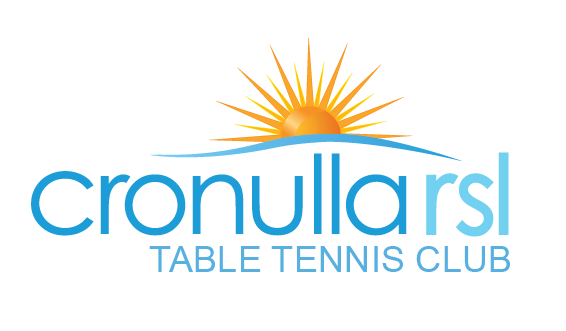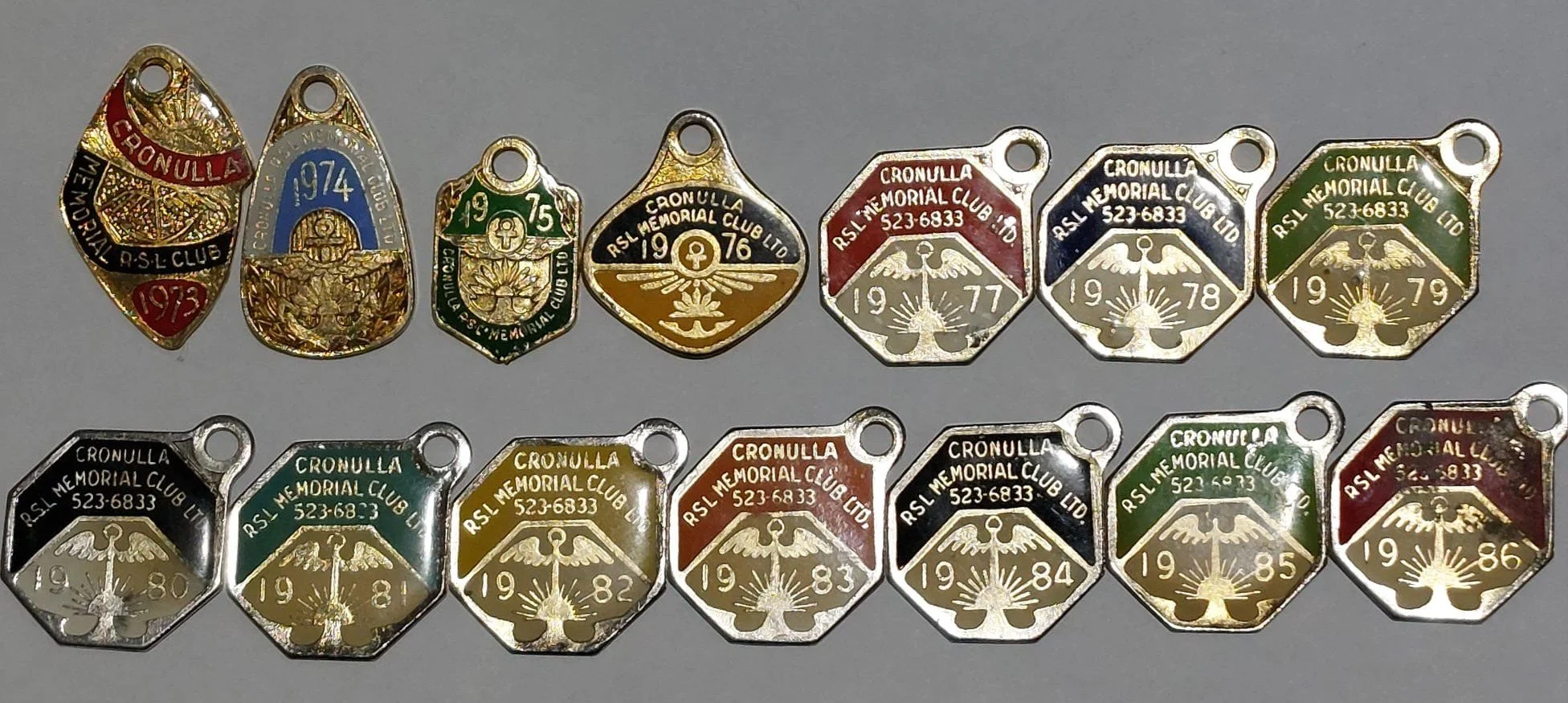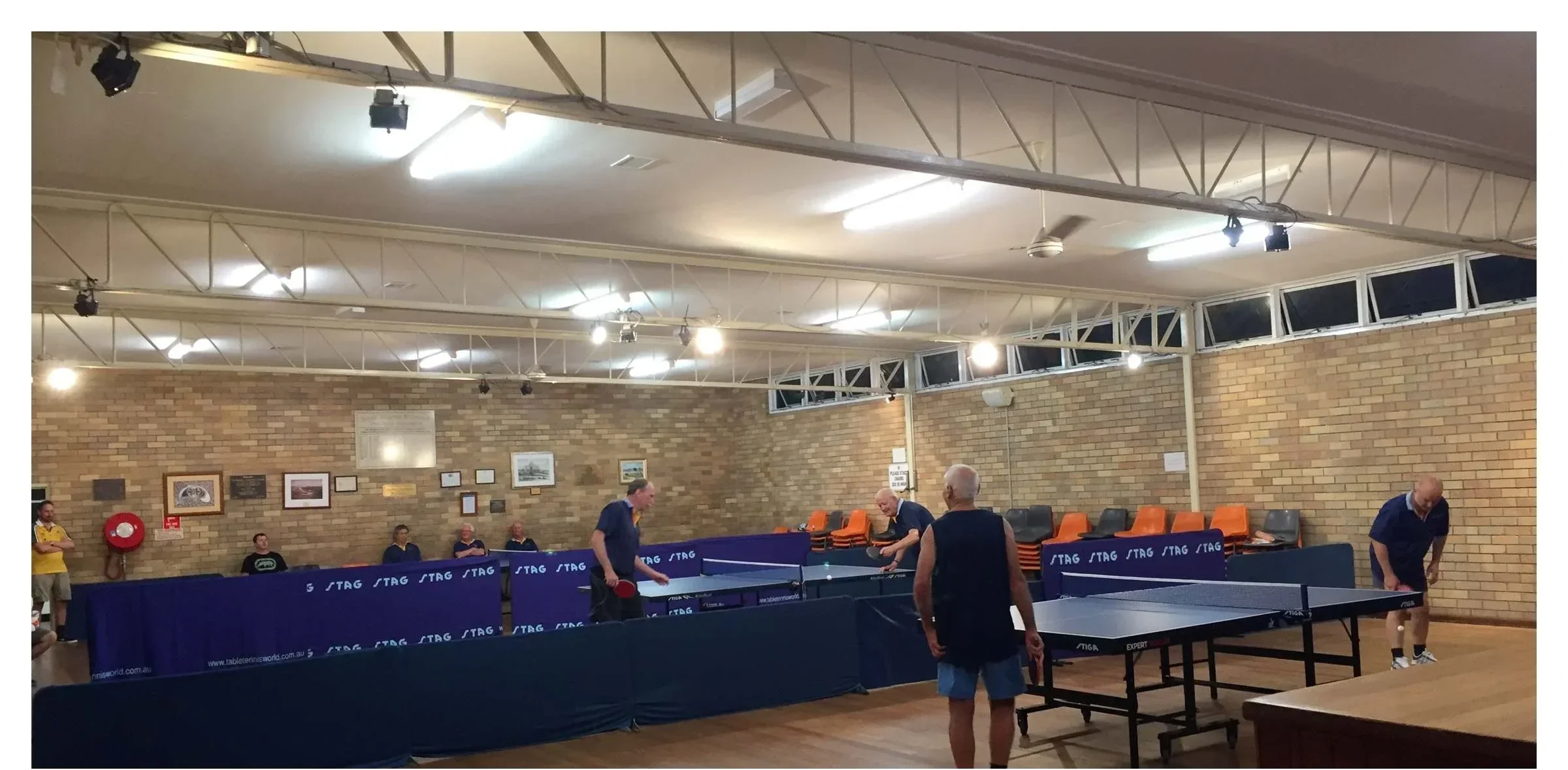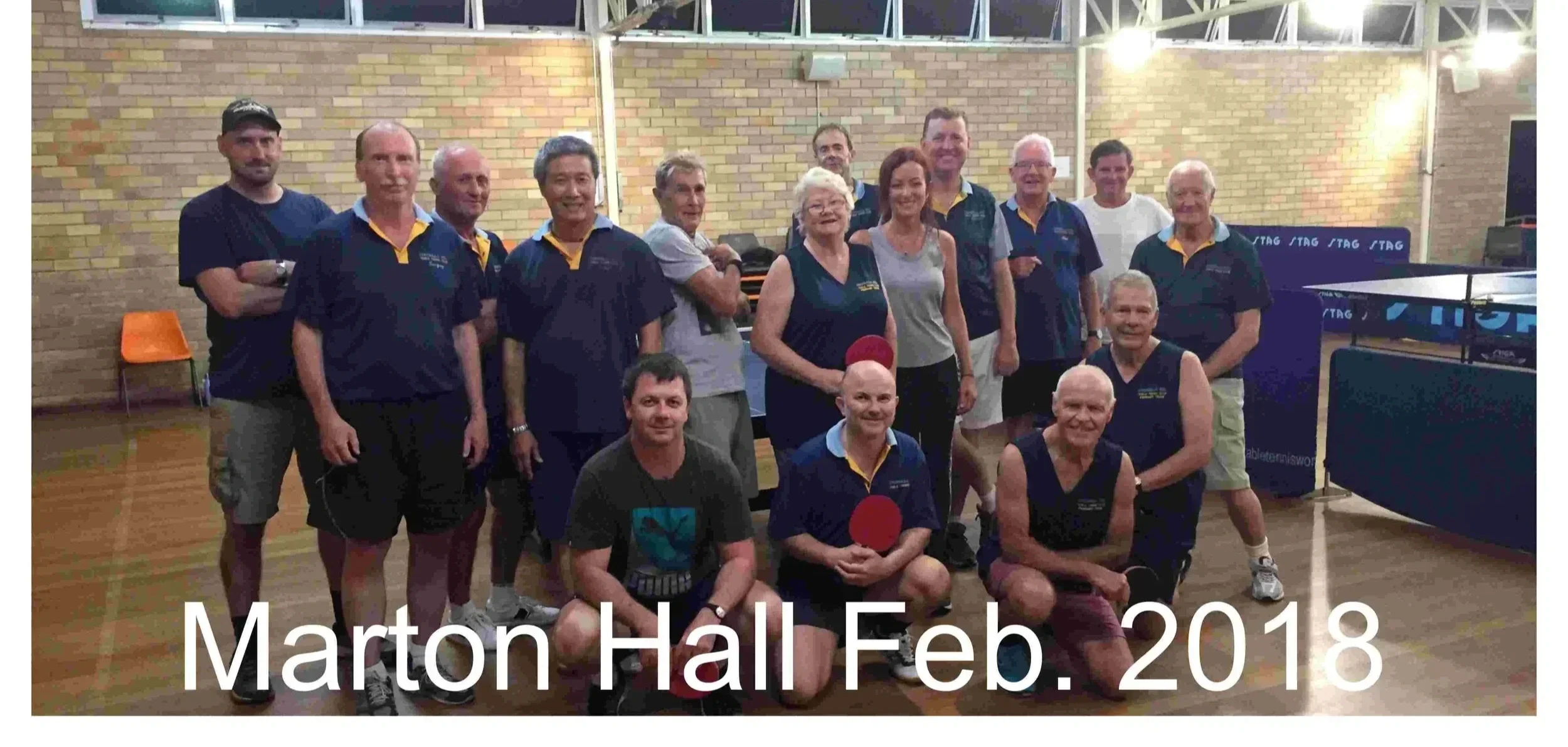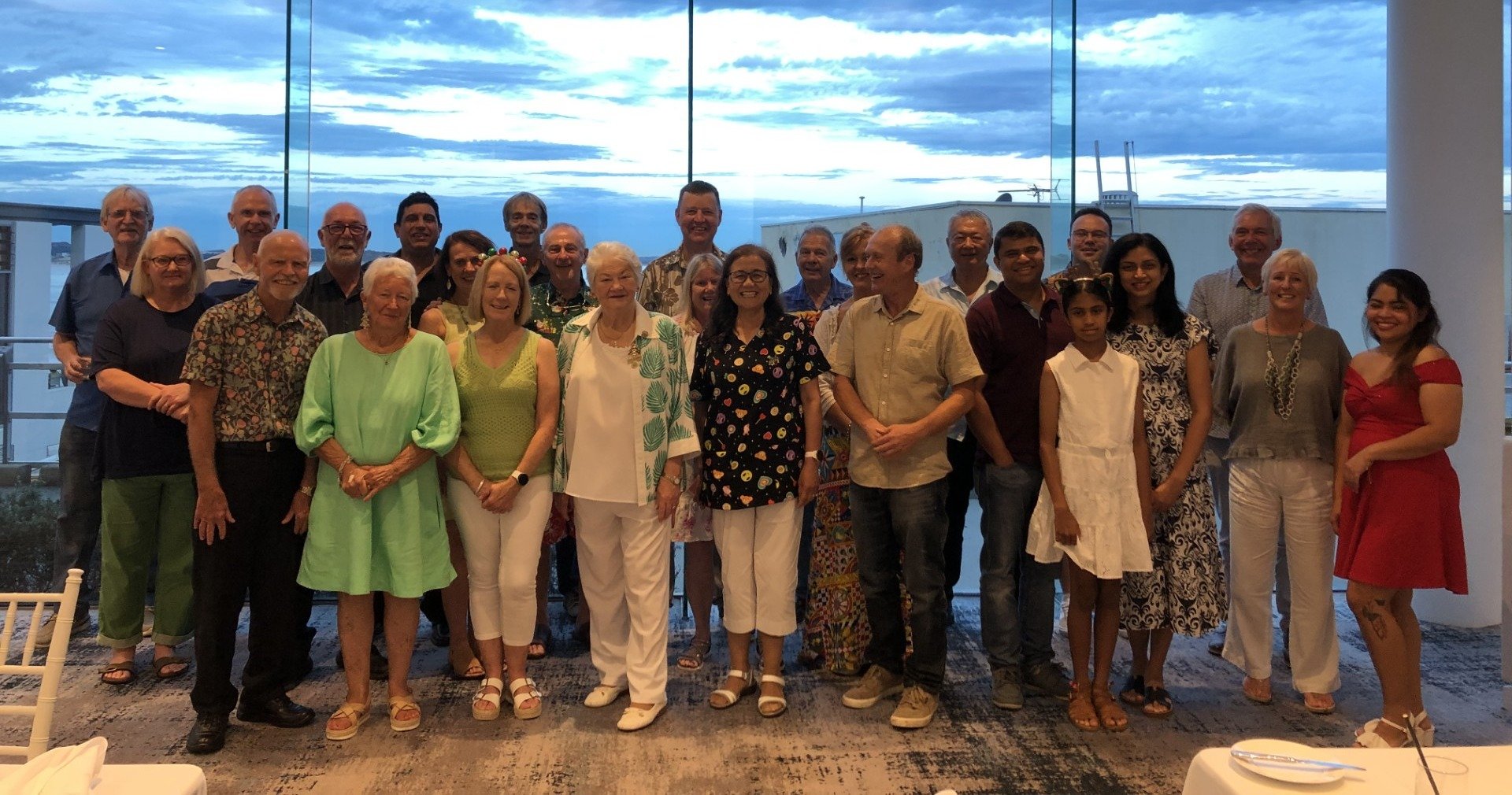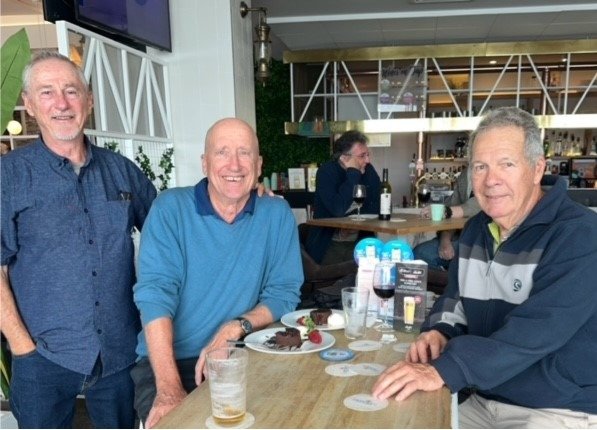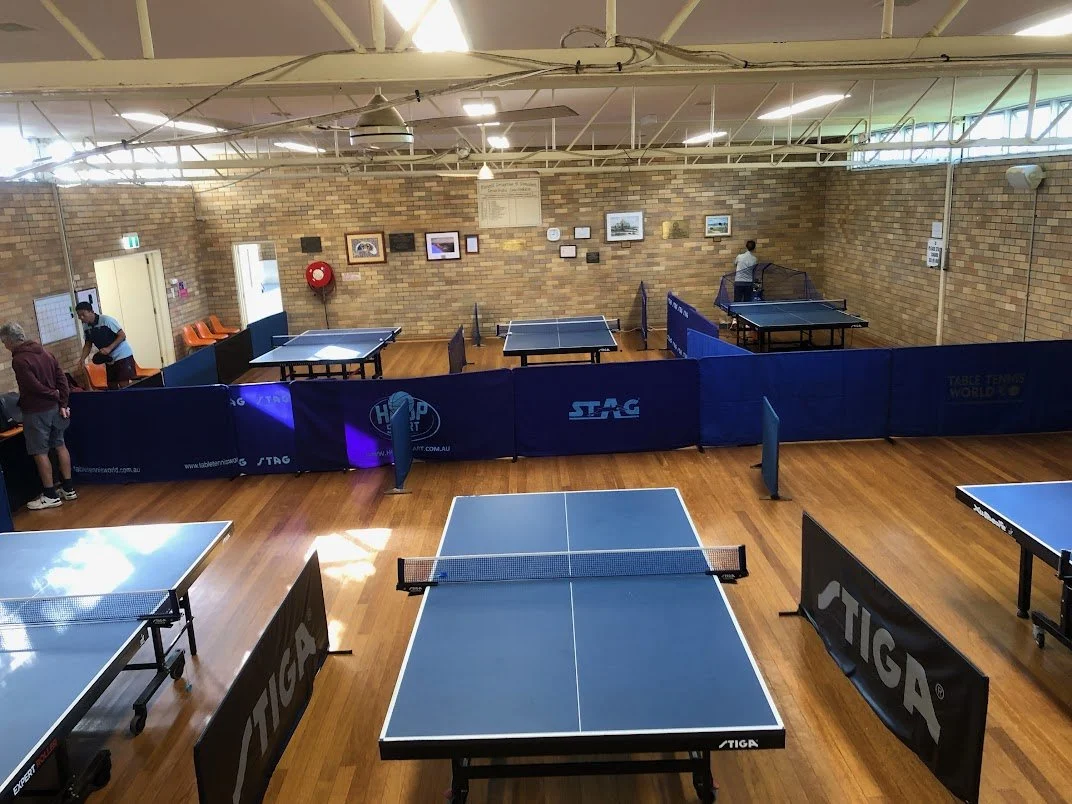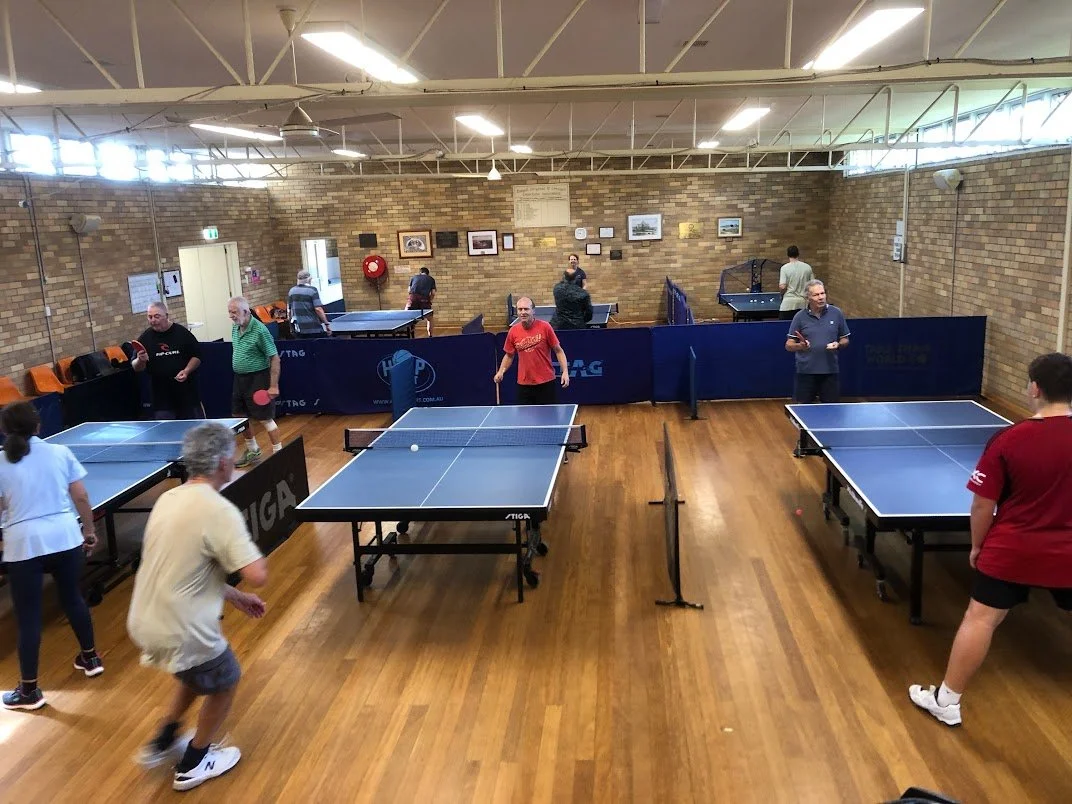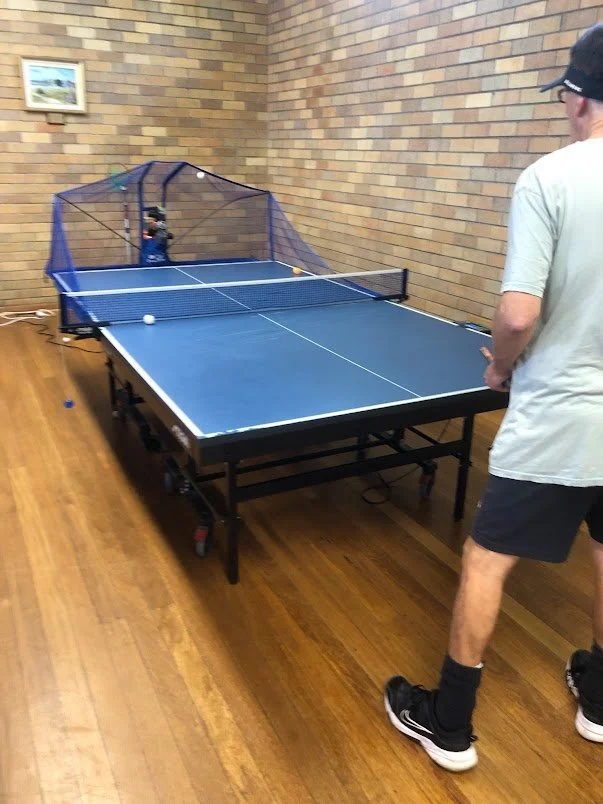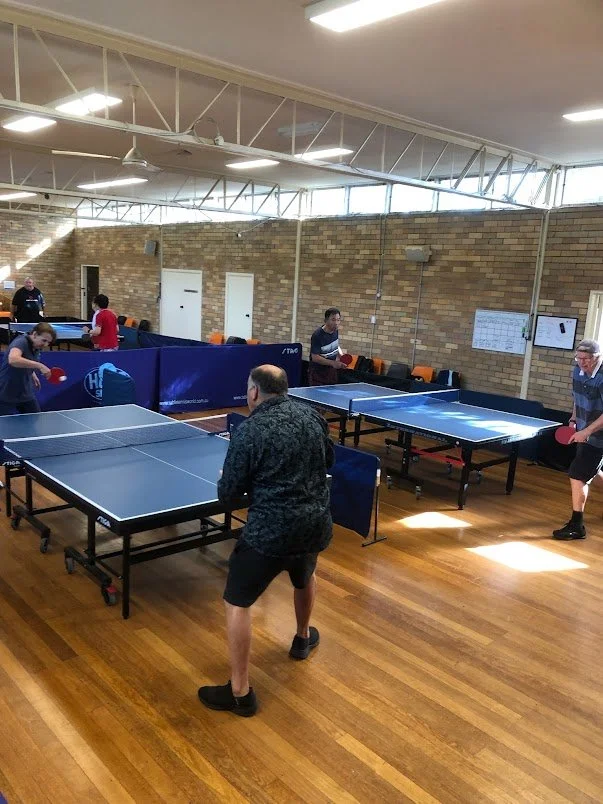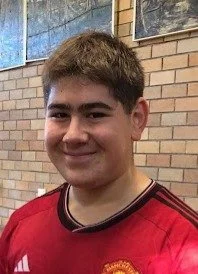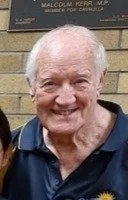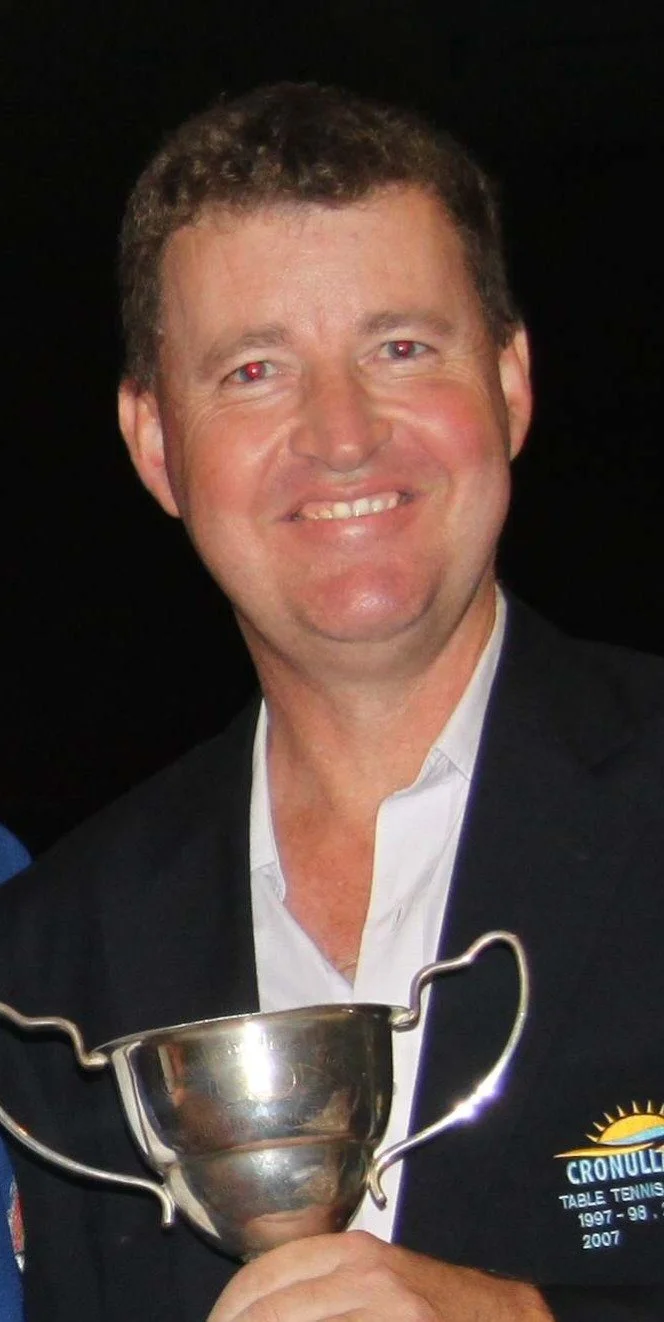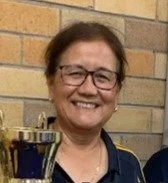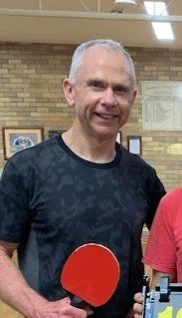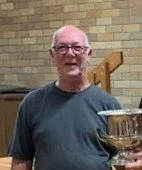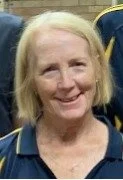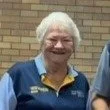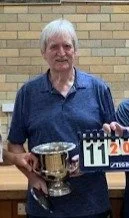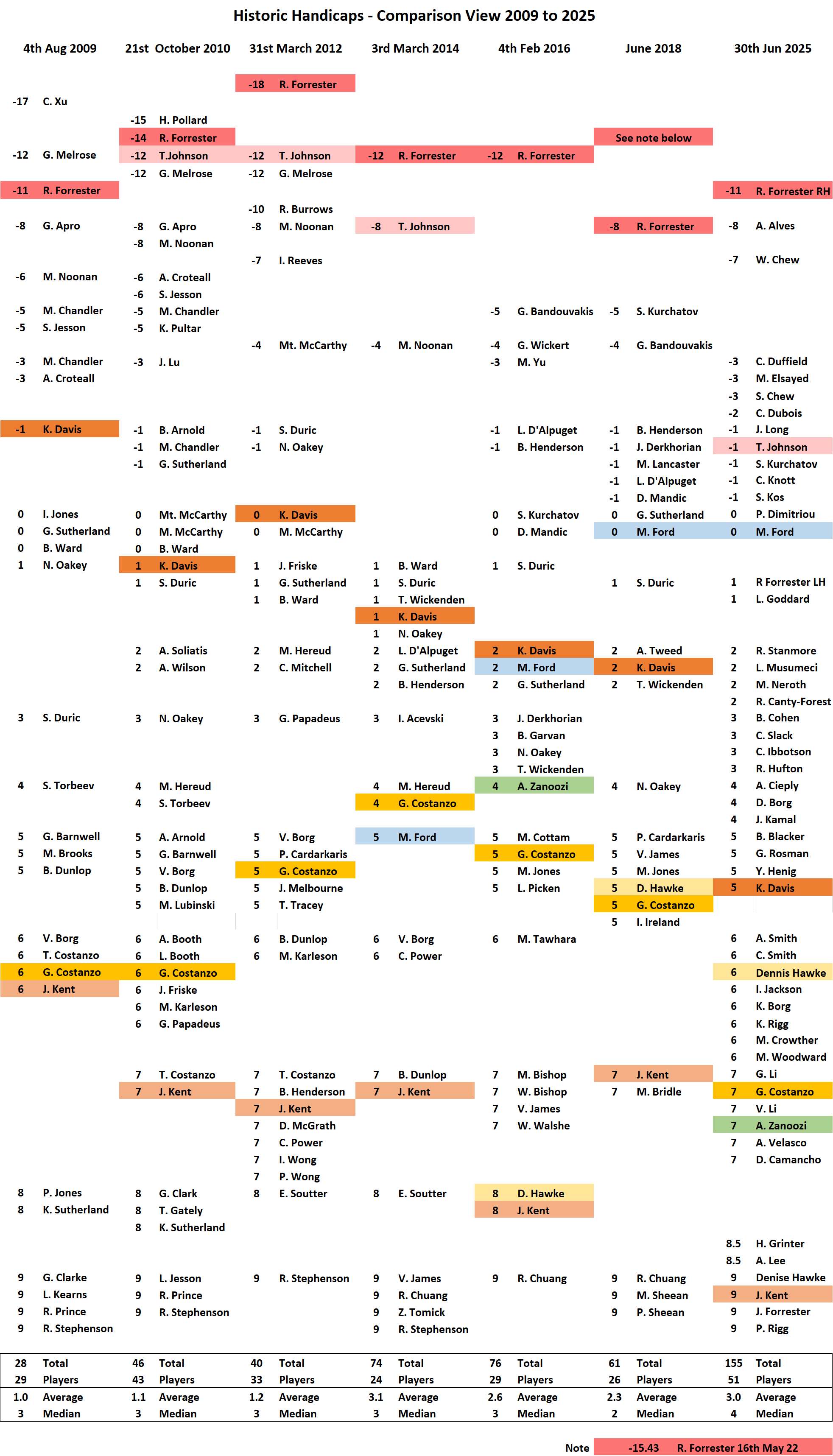Introduction to Our History:
Table tennis being played at the Cronulla RSL goes back over 75 years. Unfortunately, over that time a lot of records and history have been lost. However, in June 23 we were contacted by Bruce Roberts whose history with the club as both a multiple Club Champion and President goes back over 50 years. Bruce took the time to put together a history of our club, concentrating on the 60’s, 70’s and early eighties.
It was because of Bruce doing this that the committee realised that the rest of our club’s history also needed to be written down and preserved while we have access to both the information and the critical members of the club. The history of our club has now been extended from where Bruce left off in the early 80’s through to mid-2025.
We thank Bruce immensely for what he has produced and for the spark that his work provided in encouraging us to complete the full history of our club.
The following ‘A Snapshot in Time’ document which Bruce produced is invaluable information for our club because it captures the essence of the fun, competition and friendships that the club provided for many members and visitors over several decades. His document is now ‘Part 1’ in our full history.
Following on from Bruce’s document below is the history of the club from 1983 to the end of June 2025 and is entitled ‘Part 2 – Another Snapshot in Time’. We hope you enjoy reading about the club that we feel fairly certain is the premier table tennis club in the Sutherland Shire.😊
PART 1
“A SNAPSHOT IN TIME” - 1960’S TO EARLY 1980’S
PREAMBLE
The Cronulla RSL Sub Branch, which was formed in 1942, leased a couple of rooms at the Cecil Hotel, South Cronulla. These were used mainly for sub branch activities, but eventually expanded to include more “social” activities, including dances and other social functions. A few poker machines were installed and the RSL “social club” was born.
A few years on, the sub-branch purchased land in Gerrale Street, the current club location, and commenced development and construction of the new club soon after. The Cronulla RSL Memorial Club was completed with the doors opening for business in June 1953.
Cronulla RSL Memorial Club “History” alludes to the fact that the first sporting “sub-clubs” were formed AFTER 1953 (ie. Fishing, Swimming, Billiards and Snooker), however there is clear evidence that some sub-club activity was present before then. Both the Swimming and Fishing clubs, for example, were active from around 1950 or earlier.
Again, Cronulla RSL “History” alludes to the fact that the table tennis “sub-club” and a few others (ie Darts, Indoor Bowls, Outdoor Bowls, Golf, Rugby League) were formed closer to 1960. Yet, the table tennis “Singles Club Champion” Trophy (ie the W T Franklin Trophy), has two names engraved on it “K Lawless” and “G Emerson” for the years 1947 and 1948 respectively??
Unfortunately, these two names and their timing appear to be a bit of an “enigma” as “regular activity” and evidence thereof for the table tennis club in any form don’t really emerge until 1961.
As a result, this document/paper will focus on the early ‘60’s as its starting point.
GAME NIGHT
Thursday night was the designated “game” night, and from at least 1961 till the late 80’s or early 90’s, the games were played on the dance floor in the main lounge of the club.
The club had 5 tables. 3 were used for Thursday night play, 1 was kept exclusively for the district competition nights, and one for ladies night.
Now when I say “table” I don’t mean two sides folded together, rolled out on wheels and set up in seconds. Each table had “6” parts to assemble (excluding the net). The “table top” was in two pieces. There were two long “timber support beams” which would lock into 2 “A” shaped timber footings/legs. The weight of these tables was significant.
On a normal monthly night (ie not a trophy/championship event) each player would play 3 singles matches and one doubles match. Players would need to register by 7.45pm with games starting at 8.00pm. The night often went on till well after 11.00pm.
“Games” were played “first to 21 points” with an advantage of 2 points. All matches were played on handicap, including the “trophy” nights. The only events played without handicap were the club singles championship and club doubles championship.
There wasn’t any “grading” (ie A, B, C etc). Everyone played everyone else based on a random draw under the handicapping system.
Up until about 1980, there were no “plus” handicaps. The “least proficient” player would be on or around “0” and the rest of the players would be scaled up from there depending on their ability. Handicaps were adjusted monthly and would go up or down depending on results. If you won a trophy in any given month you would receive an automatic 10 point “penalty” on your handicap. This was done so that there was an equitable distribution of trophies as best as possible.
Given the large number of members and a vast range of skills, the best player in the club would often end up on a handicap over 100, meaning, should he draw the “least proficient” player he would be most likely giving him around 100+ start. It would make for a long game. Also, it wasn’t a very “entertaining” match for either player. As a result, “plus” handicaps were (eventually) introduced around 1980 which helped overcome this issue and “shorten” the night considerably.
The club “year” began on 1st April and concluded the following March 31.
The singles club championship was contested in July and the doubles club championship in November each year.
These naturally were the 2 most prestigious (and therefore sort after) events, followed by the “Yearly Point Score”, which was awarded to the player who registered the most wins throughout the entire year (ie 1st April to 31st March). The winner often regarded as the most “consistent” and most “successful” player in any given year.
The yearly point score “standings” would come under regular scrutiny closer to the end of the year by those in contention which added to the “prestige” and excitement of the contest. There were also prizes for 2nd and 3rd.
There were many other defined “trophy” nights, often named after the donor of the event. These were scattered throughout the year. Many, if not all of these are still contested today.
The matches were played in good spirit but were still very competitive. These being pre “RBT” times, quite a bit of “amber fluid” was consumed on the night. On many occasions a group of us would retire to one members home in South Cronulla after game night concluded, for a “coffee” and port. Time would often get away and arriving home in the “wee hours” was a regular occurrence. I have a “not so pleasant” memory of my dear wife calling out to me as I quietly came through the front door on one such night “Don’t bother putting the garbage bin out, he's gone!”
There was also strong rumours that Arthur Williams spent his lunch breaks at work on Fridays curled up asleep in the back of his HD holden in the work car park at Warwick Farm.
Alas, working on Friday was a real challenge for many of our members.
Ladies Night - On the last Thursday of every month wives, partners and girlfriends would be invited along and would play an “event” on handicap on a 4th table set up on the carpet at the back of the lounge. During this period, there were no female members of any sub club.
This wasn’t just a “hit and giggle” event. The competitiveness was equal to any of the men’s events. Not surprising to see the names “Penrose” (Rose) and “Williams” (Peggy) appearing on the winners list more often than not.
THE 60’s
Although I wasn’t a member of the table tennis club myself until 1971, I remember many conversations with fellow members who were present in the 60’s, so I think I can reflect on this time with reasonable confidence and authority.
As there weren’t any “associate” members at this time, all members of the table tennis club (and all other sub-clubs) were return servicemen. Most, if not all, were WW2 vets, having served both in Australia and abroad. They were mostly in their 40’s and early 50’s.
Given the uncertainty of the “formation date” of the table tennis club, it wasn’t clear if there were any WW1 Members at this time (or in fact earlier), although conversations I had with some of the players who were members at this time suggest that there wasn’t any.
Having said that, the names Lawless (1947) and Emerson (1948) continue to come to mind. One thing we do know is that ’47 and ’48 were the first 2 years that the singles club championship was contested, as it states it on the trophy. Whether that is the first two years of the table tennis club as a whole we don’t know.Then there is the name/donor on the singles club championship trophy “W T Franklin”. Who was he? Was he a member of the table tennis club or just a member of the memorial club who generously donated the trophy? He may well have been an early “pioneer” of the table tennis club back in the 40’s at the Cecil Hotel? Sadly, we will never know for sure.
In doing a bit of research I came across a “William Thomas Franklin” who lived in Darook Park Road Cronulla. He passed away in 1968 aged 69. There is more than a fair chance he is our man.
A bit more research and we discovered the full names of our first two champions – Kevin Charles Lawless (’47) and George Oliver Emerson (’48). Kevin was 29 when he won the singles club championship. He passed away in 1960 aged just 42. George was 38 when he won the championship. He passed away in 1993 aged 83.
In the early 60’s, among the leaders of the table tennis club were names like Len Parry, Syd Grant, Ted Grainger, Ted Dellar, Leon Deards, Fred Quested, Bruce Green, George Stearn, Francis Fortune, Len Blyth just to name a few.
There were definitely some characters amongst this lot. Bruce Green was a school teacher by trade but also a renowned magician and hypnotist, going by the stage name of “The Great Mafisto”. I have first hand knowledge of his skills as a hypnotist. When I was in 5th form at high school (1968) he had me running around the school hall cackling like a chook at a school concert night (along with a few other unsuspecting students)
Lenny Parry was also a good bloke to know as he was general manager of EMI records, and was always happy to pass around a few “samples” if prompted. Most of these guys were still members in the early 70’s but they essentially were “non playing” members by the mid ‘70’s.
It wasn’t long before names like Arthur Williams, John Penrose, Geoff Hennessy, Perc Hancock, Bob Chapman and others became integral parts of the club, and would continue to be so for a long time to come.
The singles club champion on the honour roll in 1961 was one “H (Herb) Manglesdorf”. The name “Manglesdorf” was “iconic” within the memorial club throughout the 60’s and 70’s, but not in Table Tennis.
Herb, and his brother “Les” were both multiple singles club champions in Billiards and Snooker. Both were state ranked players for many years.
It is quite possible, if not highly probable, that Herb Manglesdorf is the only “individual” club champion in two different sports/sub-clubs with the Cronulla RSL Memorial Club.
In the 60’s and most of the 70’s the memorial club was quite generous in its support of its members. For example, cheese and biscuits on all the bars was the norm all day every day.
Also, 3-4 nights per week, the “dining room” would put on a supper on the lounge floor for all members free of charge, things like curried prawns and rice in winter, and cold meats and salads in summer.
In those days, the “dining room” was leased out by the club. One of the many trophies played for at the table tennis club then and still is today is the “Jack Anastas Trophy”. Jack was a member of the table tennis club but I doubt he ever picked up a bat. He ran the dining room for most of the 60’s and early/mid ‘70’s. He had an affinity with the table tennis club, mainly due to the fact that he was a close mate of John Penrose. Needless to say our presentation night dinners and competition night suppers were always a bit “extra special”.
In regard to the action on the tables in the 60’s, following Herb Manglesdorf in ’61 the rest of the decade, and half of the next belonged exclusively to two players, John Penrose and John Harvey.
They won 13 of the next 14 years club singles championships between them. John Penrose winning 8 and John Harvey 5.
Both “Johns” had very different playing styles. John Penrose, who was also affectionately known as “Tubby”, was a short, squat in stature man with lethal backhand and forehand drives and flicks. Because of his “low centre of gravity” he would dominate the middle of the table and was almost impossible to shift. JP was all aggression and had an uncanny ability to “hit through” underspin, which made him extremely difficult to subdue.
On the other hand, John Harvey was a tall, thick set, powerful man, who, in table tennis terms you would define as a “spoiler”. JH could chop the head off the ball and also possessed an extremely challenging range of serves. JH would simply wear you down. He was the one man during this period that was JP’s equal. JH wasn’t a regular on Thursday nights mainly turning up close to the championships. John was a civil engineer with Department of Main Roads (DMR) and also played in the city businessmen’s competition.
Despite the dominance of the two Johns, there were a number of other quality players who weren’t far behind. Players such as Arthur Williams, Syd Grant and Geoff Black were always in the mix but just couldn’t get past these two strong adversaries, time and time again. Ken Eldridge was another formidable opponent. Ken didn’t attend many Thursday nights but represented the table tennis club with distinction in the “A” grade district competition. He was also a regular semi-finalist in the singles club championship but always fell just short against the “two John’s”.
In addition to his dominance as a singles player, John Penrose was also a much sought after “doubles partner”. He won “10” doubles club championships in the 60’s and 70’s, five in each decade. In the 60’s he partnered up with Fred Quested in ’64 and ’66 to ’69.
In the 60’s through to the mid ‘70’s, all our members were “self - taught”. To the best of my knowledge, none of our members during this period received any specific “tuition” or “coaching” on the finer points of the modern game, particularly skills like heavy forehand and backhand top spin.
Probably around 30% - 40% of our members in the 60’s played with a “pen grip”, mostly using flat bats/paddles with little or no rubber to speak of. Others used “off the shelf” bats with a modest amount of rubber thickness, with one or two (eg John Harvey) who used to “build” their own bats with specialised rubber to impart as much spin as possible.
THE 70’s
My dad, Brian Roberts, was a returned serviceman (WW2) and a member of Cronulla RSL Club.
In 1969, the first intake of “Associate Members” was approved by the board. To be eligible you had to be a “son of a member”. I turned 18 in October 1969 and immediately joined the memorial club.
In early 1971, a good friend of mine, who was also a “son of a member”, encouraged me to come along and have a game of table tennis at the club. His dad was a member and secretary of the table tennis sub club, his dad’s name was “Geoff Hennessy”.
I went along with my friend one night for a look. I had never played a game of table tennis in my life to that point, although I was reasonably proficient at tennis.
After that first night I was hooked, and I joined the club the following week.
In the early 70’s, more “sons of members” joined the table tennis club. In addition, a number of “National Service Conscripts”, who were “called up” for duty during the Vietnam War, also became members, giving the club a wider spread demographically.
Ye Olde Badge System
Ages now ranged from early twenties through to early 60’s, with membership numbers well over 40. Thursday night attendance was generally in the twenties, some nights as many as thirty.
The injection of many young players into the club seemed to lift the “energy and enthusiasm” of the older members and despite the age differences the comradery across all generations was strong and positive, as was the competition.
Also, the mid-seventies saw associate membership being offered to all and sundry, and all sub-clubs had an influx of new members as a result. Again, this presented opportunity for a “wider range” of skill and diversity to join us at the table.
The mid seventies also saw a “changing of the guard” in regard to dominance at the table. John H and John P had a stranglehold on the top spots in the first half of ’75, but ’76 saw a shift in that momentum.
Winning the singles club championship for the first time in ’76 was an extremely proud moment for me personally, and I think a milestone moment for the table tennis club as a whole. But it wasn’t winning the “final” that year that had the greatest impact, it was the fact that I beat “John Penrose”, club legend, the number one ranked player and current champion, in the semi - finals.
This had a massive flow on effect for the club.
As previously stated, “the two John’s” dominated the table for 14 years from ’62-’75. However, In the 7 years between ’76 and ’82 we had no less than 5 different singles club champions :
1 – Bruce Roberts (’76, ’77 & ’81)
2 – John Penrose (’78) – Just when you think you had finally broken the nexus, he pops up again in ’78 and wins it again!!
3 – Roger Massie (79) – Roger (the Dodger) Massie joined the table tennis club in ’78. Roger was about 25 when he joined us. Roger had come up from Tasmania for work and he and I played men’s cricket together. In conversation he mentioned he played table tennis so I invited him along for a hit. I thought
he said he played IN Tasmania, what I missed was he actually played FOR Tasmania. Roger brought to the club the first evidence of a “coached” player, introducing heavy forehand and backhand top spin which many members found quite daunting. He certainly bolstered the ranks of dominant players. Sadly, Roger returned to Tasmania at the end of 1980. No doubt if he had stayed his name would have appeared on W T Franklin Trophy many more times I feel.
4 – Garry Russell (’80) - Garry came to the club in the same year as Roger the Dodger. We came up against Garry many times in the “A” Grade District Competition. Garry played for Heathcote United Services Club, and was a great player. Garry married in ’78 and bought a unit in Cronulla. As a result he joined our table tennis club which again lifted the overall standard of play considerably. Garry was 27 when he joined us.
5 – Rob Penrose (’82) – Rob , John’s younger son , was definitely a chip off the old block. Rob was already a member when I joined in ’71. He was a year older than me (21). Rob was fairly “sporadic” in his attendance. Working for Qantas he spent a lot of time away, and he often was absent when the singles championship was contested. Rob won the singles championship for the first time in ’71 aged just 21. This was at a time when the “two Johns” had a stranglehold on the title. Rob had a great all - round game. Like his dad, his forehand and back hand drives were lethal. But Rob also possessed a very strong “defensive” game which made him a very challenging adversary. By the mid seventies Rob was hardly seen at all and, like Roger the Dodger, had he been more regular I have no doubt his name would also have dominated the W T Franklin Trophy many more times, just like his dad. Coaxed by his mother “Rose” however, Rob always seemed to find time to come along and contest the doubles club championship in the early 70’s, partnering hid dad John. As a pair they were pretty much unbeatable. Rob and John won 5 doubles club championships on the trot between ’71 and ’75.
With this group of players and many others leading the charge, Toward the end of the ‘70’s the standard of play was as strong as it has ever been. Any one of a handful of players could have won the singles club championship on any given day, which was fantastic for the club. Just getting to a semi-final of the club singles championship was a great achievement, let alone making the final or in fact winning the title.
This also made for a far more competitive doubles club championship. Whilst the Penrose “Father & Son” combo dominated the first half of the 70’s, the latter half of the decade saw 3 different combos have success. It was great to see Arthur Williams team up with his son Peter and take out the doubles title in ’78. Arthur won his first doubles title 15 years earlier in ‘63.
Again, there were many “characters” amongst our members in this decade as well, many carrying over from the 60’s.
One who stands out for me was our resident Irish man “Bill (Billy) Malone”. Billy would have been the oldest (active) member of the club in this period, and was in his ‘60’s when I joined in ’71.
Billy spoke fairly softly in his deep “Irish Brogue” and was almost impossible to understand, and would always finish a sentence with a raucous laugh which would only add to the confusion.
I had the “pleasure” of playing Billy many times, and as he was one of our low handicappers, it would turn out to be quite a marathon. Billy would mumble to himself right through the match and would let out a belly laugh if he happened to “jag” a net cord or edge, which he often did.
Billy was still going strong when I left the club in ’83, and I was delighted to see that he actually won 3 double club championships, in ’84. ’86, and ’90. He partnered (who else) Arthur Williams in the first two, and must have been very nearly 80 years old when he won in ’90. Fantastic.
Geoff Black - Dapper clothing! No barriers - lots of collisions and ball chasing!
Ted Grainger - Pen grip player.
THE 80’s
Coming off a highly successful decade in the 70’s, the 80’s became an extremely challenging period for the club.
By ’83, for many reasons, there had been a significant exodus of members. That strong contingent of dominant players that emerged in the second half of the 70’s had disappeared.
By the end of ’83 there was not one former or current singles club champion still at the club. Coupled with this, a large “vacuum” in regard to “Administration” of the club had also emerged.
So why was this so?
Many of the younger brigade who joined the club in the early 70’s, were now married with young families and often with demanding careers. Some also moved out of the area as their families grew. Something had to give.
In addition, quite a few of the “older” members who had been a big part of the club through the ‘60’s and ‘70’s remained passive members but didn’t feel able to participate in club activities directly.
It is fair to say that the overall “standard” of play had diminished considerably and a re-building period was essential for the future of the club.
The club was extremely fortunate to have one “Arthur Williams” who almost single handedly kept the club moving forward.
As I wasn’t part of the club past ’83 myself, I can’t really comment on the balance of the decade and will leave that to others to narrate in time, hopefully.
Having said that, I was delighted to see on the honour roll that Arthur Williams finally broke through in 1984, winning the first of 5 consecutive singles club championships, 24 years after he joined the club.
THE COMMITTEE
Like most clubs, a handful of the same people generally put up their hands to help run the club. The table tennis club was no exception.
The committee consisted of:
President
Vice President
Treasurer
Secretary
Captain
Publicity Officer
Ordinary Committee members (no limit)
It is difficult to be precise about who did what, particularly in the 60’s, but here is a very indicative list:
President
Fred Quested was the President for the period ’61 to ’64.
Ted Grainger was the President in ‘65.
Arthur Williams took over this roll in ’66 and held the position continuously until 1976
Bruce Roberts was president for from ’77 to ‘80
Arthur Williams was President from ‘81 to ‘83.
Treasurer
Ted Grainger was Treasurer for the period ’61 to ‘65
John Penrose took over this roll in ’66 and held the position continuously until 1978
Mal Hall was treasurer for 5 years from ’79 to ‘83
Secretary
Syd Grant was Secretary for the period ’61 to ‘65
Geoff Hennessy took over in ’66 and held the position until at least ’83.
Captain
Francis Fortune was Captain for the period ’61 to ‘65
Bob Chapman took over in ’66 and held the position until ‘74
Bruce Roberts was Captain in ’75 and ‘76
Arthur Williams was Captain in ‘77 and ‘78
Graham (Pommy) Eyre was Captain from ’79 to at least ‘83
Publicity Officer
I understand that ‘Geoff Black” held this position from the early 60’s through to the early 80’s, as his contribution to the administration of the club. Geoff was a quiet, unassuming man, never attended a committee meeting in all that time but always had a “report” for the club magazine without fail.
Committee Members
In addition to our “office bearers”, there were many “behind the scenes” members who gave up their time to help the cause of keeping the club moving forward.
In addition to others that have already been acknowledged, names like Perc Hancock, Phil Peyton, Mark Bishop, Paul O’Neill, Terry Blaikie and others I am sure I have missed or forgotten.
On the first Monday night of every month the committee would meet. Meetings were held at a different committee member’s home each month. Apart from business at hand, this was (yet another)
social event and a good excuse for a few beers with your mates. Everyone would turn up with the standard “foam esky” with a 6 pack inside and the host was responsible for supplying a bottle of club port to have with supper (begrudgingly provided by the wife of the host)
DISTRICT COMPETITION
The Cronulla RSL competed in the St George and Sutherland Shire Table Tennis Competition on a regular basis during this period.
Teams were normally entered in A, B & C grades. The standard was very high. Our club had success in the minor grades on a number of occasions but never won an A grade championship during this period, despite going close a few times in the late 70’s.
Competition nights at our club were held in the “Annex”, an area at the rear of the lounge area. Most sub-club presentation nights were also held here.
Sometime In the early 80’s comp night moved downstairs into the sports bar area, where the indoor bowls mats would be rolled up and a table was set up in that area.
A number of “clubs” in the Sutherland/St George area participated in the district competitions, including St George Leagues, Cronulla Leagues, Miranda Builders and Business Men’s Club, Heathcote Returned Services Club, Kogarah RSL.
But there were many “teams” whose venues were far less elaborate than at a licenced club. Scout/Community Halls, Rumpus Rooms, Garages etc were quite common.
I recall on one occasion Arthur Williams, myself and Perc Hancock were playing a “B” grade match at someone’s home at Cronulla. They had a table set up in their lounge/rumpus room. At one end of the table, about 6 feet away was a huge glass window and at the other end was a wall about the same distance away. Now both Arthur and myself liked to stand back quite a bit from the table while playing. We both looked at each other and we asked our “opponents” if they had insurance cover, not just for the glass but also for Arthur and myself.
They agreed that Arthur and I could play all our games at the other end of the table.
Another “challenging” venue belonged to a team respectfully referred to as “the 3 old ladies”. They had a table set up in their garage at Bardwell Park. There was literally only about two feet of room at both ends. This was considered very “strategic” by the ladies as all three stood glued to the middle of the table, using wooden paddles with pen grip.
One of these lovely ladies was the world renown “Dorothy (Dot) De Low”, who was still playing competitive table tennis right up to the time of her passing at age “103”. Dot played in many international events in her 80’s and 90’s. What an amazing woman.
Fortunately, bat standards came under close scrutiny and regulation in the mid 70’s. There were many “hybrid” bats being developed which were way outside the norm. Firstly, wooden bats/paddles were banned around this time from all competition play. There was also a type of bat that would pop up from time to time in competition. In essence, it would have what was defined as “reverse nipple”. This meant that the “nipples” on one side of the bat were not straight up but were slanted toward the handle. On the other side of the bat the “nipples” were slanted in the opposite direction, ie the top of
the bat. This had the effect of imparting two completely different types of “spin” on the ball whilst the player appeared to play the same shot. The player would also spin the bat in his hand during each point so his opponent did not know what to expect. Fortunately, these bats were also banned.
For some strange reason our club used “Barna” table tennis balls whilst the rest of the “world” used “Nittaku”. There were quite a few “heated” discussions on comp night when visiting clubs insisted on using their balls. The club finally switched to “Nittaku” balls in the mid 70’s.
There were many very talented players in the district competition. Names like Geoff Nesbitt, Neville Russell, Dave Beaumont, Ray Smith and an emerging talent who was only 14 in the mid 70’s, his name was Wayne Heginbotham.
Dave Beaumont was one of the infamous Beaumont family who played with Kogarah RSL Table Tennis Club. The whole family participated, Dad Bob, Mum Thelma, Sister Michelle, and a few more cousins and uncles.
Dave was a great player but was very much averse to losing a match. If you had the better of David in a match he would try and disrupt your concentration by going to the bathroom half way through a game, or, as he did on one occasion when I was playing him, he stopped play mid point and complained that someone had tampered with his bat, so he sat down and proceeded to “re rubber” his bat there and then.
The district association would also run tournaments from time to time which our club participated in with some success.
MONRO TROPHY
Each year the various “sub clubs” would compete against each other for the coveted “Monro Trophy” Each sub club would host an event in their particular sport and all sub clubs would compete. Points were awarded – 3 for first place in each event, 2 for second in each event and 1 for third in each event.
There were 10 sub clubs and therefore 10 events each year. The team with the most overall points would win the Munro Trophy for that year. The events were scattered over the whole year.
The competition was indeed fierce with large crowds gathering at the various events to cheer on their champions.
The sub clubs were:
Table Tennis
Billiards & Snooker
Golf
Indoor Bowls
Outdoor Bowls
Swimming
Fishing
Rugby League (Quoits)
Darts
Toastmasters
During this period, the table tennis club used to dominate the Monro Trophy winning the overall title many times and far more than any other sub-club.
We were very fortunate to have a lot of “talent” in many other sports within our membership. John Harvey and another member John Wilson were both scratch golfers so we triumphed at that event many times. We also, amongst the younger members, had some very good “A” grade snooker players, and excellent swimmers.
We were also regular winners in the “toastmasters” event, with skilled public speakers like Bruce Green, Alan Bourne, Paul O’Neill and Phil Peyton leading the charge.
Also during this period, the table tennis club was the only sub club who was undefeated in its own event.
OUR CLUB
Despite the wide gap in ages, the table tennis club was a very social group, many members forging long and close friendships with fellow members.
There were often many social events held outside of playing table tennis. A golf day was held on the last Sunday each month and was very well attended by members, wives, partners and girlfriends, culminating with a BBQ back at someone’s home.
Thursday nights were very competitive but also very social.
There were also many other social gatherings, dinners, weekends, trips away enjoyed by many of the members.
The social integration between our members I think was the catalyst that made our club so successful during this period.
Our club management were also very “strategic”. They would always offer “honorary membership” to whoever was secretary-manager of the memorial club at the time. Through the ‘60’s and early’70’s that was “George Moore” who lived next door to the club. His successor “Bob McKinlay” came on board as well, which meant the table tennis club were always “well looked after”.
In addition, John Penrose was a senior ATO executive, and nobody wanted to get on the wrong side of the “tax man”
When I left the club toward the end of ’83, there were no “female” members of the table tennis club, even though associate membership had been opened up for women by the memorial club sometime around the mid to late ‘70’s. I also recall that women who served during WW2 were pushing for “full membership” of both the sub-branch and memorial club which was ultimately granted.
Just like it was for “sons of members” those early days of membership of the memorial club were challenging for the women, trying to fit in to this “male dominated environment””
I will never forget a particular day when I was playing snooker in the downstairs games room. Here you had 5-6 snooker tables all full, lots of smoke, drink and plenty of rowdy chatter. A real “men’s domain”. If you want to play a game and the tables are full you have to put your initials and badge number on a blackboard on the wall and wait your turn.
On this day, a woman walked into the snooker room and commenced to write her initials and badge number on the board. You could have heard a pin drop as the whole room stood still. When finished she turned around and walked back into the bar area. The noise returned and the snooker games continued. A new era was born.
Again, I don’t know when and who was the first female member of the table tennis club, but I suspect it was quite some time after I left the club.
However, looking at the table tennis club website today it is fantastic to see the strong female presence and participation in the club at all levels.
If “Rose” and “Peggy” were alive today, they would be extremely proud and pleased.
Finance/Administration/Communication
All the sub-clubs had little or no financial support from the memorial club, except for some initial funding for set up and equipment.
So essentially, the sub-clubs were left to their own devices to run and grow their club.
Each Thursday night the treasurer would put together and bring along “raffle prizes”, consisting of boxes of fruit and meat platters. The profits from these raffles would primarily fund our presentation night meal and prizes as well as other running costs for the club, including new equipment.
Annual membership fees would help defray these costs also, and some of our “passive” members would sometimes make generous donations to help the cause, which was much appreciated.
If you were really financially strapped, and needed new equipment, in our case, like a new table, you could make a formal application for funds to the memorial club secretary-manager, who would submit it to the memorial club president/board for consideration and ruling.
Success rate on these was generally fairly low unfortunately and the process quite arduous.
Of course, there were no personal computers, mobile phones etc in this period. There was no internet, and therefore no such thing as “emails” or “social media” outlets like “Facebook”. Nor were there “websites” or “Blogs”
There wasn’t programs like “word” or “excel” or other types of software applications to “automate” the administration, promotional and communication process. In essence, everything was manual.
What we had back then was the “Red Journals”.
Foolscap, hard cover red journals, consisting of 100 lined and numbered pages. These facilitated all financial, administrative, and operational functions of our sub-club “activity”.
The secretary had about 4-5, one for the committee meeting minutes, one for AGM’s and special meetings, one as a register of members, one to record formal correspondence in and out, and one for all internal and external contact details.
The treasurer had a few – one for the monthly financials, one for the annual accounts and audit, and one to record and control membership fees.
The captain also had a couple – one for the Thursday night draw, and another for recording the handicaps progressively for all members, as well as recording the basis of the “handicapping system”.
The standing “rule” to protect the integrity and preservation of all these relevant documents and records both past and present was:
“When an “officer” of the committee retired or completed his term, he would hand over to the incumbent officer all “journals” in his possession relevant to the position he held, including those he inherited from his predecessor”
It was the responsibility of each officer to keep these “journals” in a safe place until the day came to pass them on.
I remember clearly when John Penrose “handed over” the treasurer role to Mal Hall in ’79. Being mindful that John had been treasurer for 14 years. Now Mal and John lived quite close together and Mal rang John and said he was going to walk around and pick up the “books”. John burst out laughing and said “have you got a truck?”
The same would have applied to Geoff Hennessy who held the position of secretary for at least 18 years that I am aware of. Geoff would fill two minute books a year at least, along with the other journals he used and maintained. I pity whoever took over from Geoff.
I have no idea at what point in time the “journals” were discontinued. But the quantum of journals at that point must have been unbelievable.
I can only imagine the stories that they would tell today, but alas I suspect they ended up in “land fill” quite some time ago.
WHO WAS THE BEST PLAYER?
The question as to who was the best player during this period has been asked often.
Having won 9 singles and 10 doubles club championships over a 17 year period, JOHN PENROSE was the standout.
Were there players who “at their prime” could have beaten John “at his prime”? The answer is most likely “yes”, but not as often as he beat them.
A significant event which had a profound and lasting effect on our table tennis club was the sudden death of John Penrose shortly after Christmas in 1981. John was only in his early 60’s at the time and still an integral part of our club.
John was a legend, and was much loved by all at the club, as was his lovely wife Rose. His contribution to our table tennis club was significant in so many, many ways.
A true gentleman, champion bloke, and dear friend.
WHO ELSE MADE A DIFFERENCE?
You always run the risk of forgetting someone when you are asked this question. There are many members whose names appear in this paper who worked tirelessly for our club over such a long period.
However, there are a few members who, I believe, in addition to John, deserve a special mention during this period:
Geoff Hennessy
A great club man who was our secretary for many years. Geoff was a “calming influence” and had an ability to “defuse” debate and get things done. He was also a real good bloke.
Geoff Black
Commonly referred to as “nature’s gentleman”, Geoff was our publicity officer “forever”. Geoff had a great sense of humour and was always a strong influence around the club.
Ted Grainger
Ted was our treasurer in the early 60’s and later on became our “honorary auditor” for many years, and would always “MC” our presentation nights. Ted also assumed the role of club “referee and umpire” and always umpired the club singles and doubles championship final each year. No arguing with “Lord Ted”. Another great club man.
ARTHUR FRANCIS WILLIAMS
It is only fitting that I leave the last piece of “history” during this period as a dedication to a man who was the heart and soul of our club during this period and would continue to be so for many years beyond– Arthur Francis Williams.
Arthur was the rock that the club was built on.
Arthur was a “large as life’” character who only knew one way to do things – flat out!
Over more than 30 years, Arthur played a leading roll in one form or another to help grow and sustain the club he loved so dearly.
If you had never met Arthur, he was a “wiry” tallish man with a booming voice, a thin face and long nose. Probably his greatest “claim to fame” was that wonderful crop of hair. He would always have it slicked back and flattened so not even the most vigorous of games would pry it loose. There was a standing order amongst members that if you could disturb just one hair on Arthur’s head during a match you would get a free schooner. No one ever collected.
Arthur was also a very good tennis player, and he applied the same “style” of play to his table tennis game.
Arthur had no backhand and no desire to use one, unless absolutely forced to do so. He would stand well back from the table and “run around” on to his forehand on every point. As a result, Arthur would cover many miles in the course of a game, moving way back and forward and also “extremely” wide on both sides. All this would happen at break neck speed to avoid having to play a back hand shot.
Essentially, this rendered Arthur as an extreme “health hazard”, and in today’s WHS terminology, “high risk”.
To put it into perspective, there was no netting or barricade either between each of the 3 tables, nor at either end or on the outsides.
If you were unfortunate enough to play a game on the table next to Arthur at the same time it was almost a “dead cert” that at some point in the game (and often more than once), Arthur would come crashing into you, with both of you more often that not ending up sprawled on the floor.
Or if he went to the outside, he would often end up crashing into one of the tables of some of our poor unsuspecting members, who were likely just relaxing enjoying a chat and a beer. I even recall on one occasion Arthur ending up behind the curtain on the stage at the top of the dance floor during a game.
In that period of time, the club still had waiters and waitresses, who would move around the floor taking drink orders. Almost every week Arthur would demolish a full tray of drinks (and the staff member carrying them), wearing most of it on himself. It got to a point where Arthur would bring a spare shirt and towel with him on Thursday nights just in case. Arthur also gave our first-aid kit a regular work out.
I think Arthur may have been the major reason why the table tennis club was eventually moved downstairs into the sports bar, and were made to erect nets around the tables.
I am not sure when Arthur finally called it a day as part of the table tennis club, I am sure though that he would have “kept in touch” with the club even if he was unable to participate. I note he won his last doubles club championship in 1996, aged 75.
I was saddened to hear that Arthur passed away in 2012, aged 91. His lovely wife Peg passed away just one month later.
It is highly likely that Arthur was the last of our clubs “pioneers” from the ‘60’s to pass away.
CONCLUSION
I am extremely grateful for the opportunity to make this small contribution to the history of the Cronulla Table Tennis Club, a club that holds a special place in my heart.
To be able to share stories about the many wonderful people associated with the club during this period is both an absolute pleasure and a privilege.
Hopefully this piece of history will stand to preserve their memory in perpetuity.
I am delighted to see the club is still thriving to this day in its new home at Kurnell. Congratulations and thank you to all who continue to make this happen.
I hope this paper puts a small smile on your face and gives you some insight into what went on in “your club” way back then.
Below are some photos from “our era”.
BRUCE ROBERTS – JULY 2023
1963 – President Fred Quested and other members of the victorious table tennis club Monro Trophy team receiving the “Cup” from the president of the memorial club. Apologies for those members names I could not remember.
1964 – Club captain Arthur Williams and his offsider Geoff Hennessy on game night. Check out the trusty “red journal” books. Sitting on the table behind Arthur (R to L) John Penrose, Geoff Black, Bob Chapman (obscured). All the boys wearing their TT club shirts (which were light blue)
1965 – TT Club president Ted Grainger receiving the Monro Trophy on behalf of the victorious TT club members.
1970 – Three shifty looking characters on an outing. (L to R) Vic Moye, Arthur Williams, Bob Chapman.
1973 – The two “Legends” of our era. Arthur Williams (on left) and John Penrose (on right) alongside their “better-halves” Peggy W and Rose P. On holiday in Norfolk Island with a group from the TT Club “Family”
1977 – TT Club in the winner’s circle again, Arthur Willams receiving trophy from Memorial Club president Dallas York
1978 – Yet another trophy for TT Club. Arthur Willams receiving trophy on behalf of the TT Club from Dallas York
1982 – Peggy and Arthur aboard the John Cadman at their younger son Peter’s wedding.
1996 – Arthur and Bob Chapman catching up with a couple of the Rugby League boys.
Some of the “gang” from the table tennis club enjoying an Easter weekend in a chalet at Thredbo, courtesy of John Penrose, who had an interest in the complex. We went there many times in the 70’s, this one was 1977.
The man himself, Arthur Williams is standing over the table in the cream/grey jumper, with wife Peg seated next to him. Bob Chapman with the grey/silver hair, is seated on the other side of the table next to Heather, his sister- in- law.
Seated in the foreground, gazing out the window is Rose Penrose.
Other members of the group are scattered around the room, whilst a small contingent would be on “kitchen duty” getting our dinner ready, under the strict supervision of John himself.
(Apologies for the poor quality photo which I took)
PART 2
Another Snapshot in Time 1983 -2025🏓
Bruce Robert’s excellent history document above, covered the period of our club from 1947 to 1983 and this follow-on document completes the history for the full period up to the present time. I have divided the 42 years from 1983 to 2025 up into 3 distinct periods, for reasons described under each sub-period’s heading.
Our website provides a lot of information on the playing aspects of the club in terms of member’s names, results, awards, statistics and activities and this document attempts to supplement those facts and figures by putting a ‘human face’ on the member’s names and to adequately describe the fun, interaction and friendships that have developed within our club over many years. It also hopefully pays due homage to those members who have volunteered their time and efforts over many years to steer our club through some lean times into our currently healthy era.
1983 - 1997
This 14-year period has been selected as an interval because it covers the time in between the end of Bruce Robert’s documented history and the period from 1997 onwards.
Unfortunately, unlike the period from 1997 onwards, this 14-year intermediate period is not well covered by historical documents, photos or anecdotal history and we have not been successful to date in contacting ex-players who can fill in the many gaps in this history. We do not know who the exact office bearers were for this period nor the details on the attendances and playing statistics, nor any information on our club’s participation in the inter-district competitions.
We do know that Arthur Williams, our club’s legend from the earlier period, and Jim Heath, both Life Members of the club, were the administrative mainstays for most of this time and we do have the results of all the annual events that were run during this period.
We understand that for most of this period the matches were played on Thursday nights on two tables downstairs in the sports lounge area where the game’s location stayed until the very start of 2018. The dominant players over this period included Arthur Williams and Norm Bray who each won five clubs single’s championships, while Geoff Ryan won two championships and Mark Wood won one. Besides these four players, other players who won more than two annual events during this period include C. Hilleard, R Mc Claren, Jim Heath, Bill Malone, F. Bedo, B. Bungard, G. Apro, G. Poulton, Greg Melrose, J. Layman and E. Hillzinger.
We also suspect that this period saw the first females officially join the club as normal members and there were other cultural shifts such as the impact of police breathalysers on social drinking habits, and the decline in the popularity of licensed club-based sports.
We would like to fill in as many gaps in the history of the club for this period as we can and maybe find records or photos. So, we would like to hear from anyone who might know some of the history, or who might know of someone else who does know, of the Cronulla RSL Table Tennis Club between 1983 and 1997.
1997 - 2017
Introduction
This period is well covered in terms of historical information due to the contributions of three long-term committee members, who all subsequently became Life Members, and who are still valued club members to this day. I will expand on the contributions to our club of Kevin Davis, Rodney Forrester and Janet Kent towards the end of this document.
During the 1997–2017 period, matches continued to be played on Thursday nights on two tables in the downstairs sports lounge area.
Cronulla RSL Sports Lounge - Two Table Set-up
Details on the various aspects of our club during this period are as follows:
Committee Members 1997-2017
Like all clubs, our success depends on the quality and dedication of our committee members, and during this time we were lucky to have had dedicated organisers who applied themselves over a long period of time. The names of all these office bearers are shown on our website’s Honour Roll page and is titled ‘Office Bearers from 1998 and Life Members’. As mentioned above, Kevin, Rodney, and Janet dominated this period in terms of directing the course of the club on the committee, but not before Arthur Williams, Jim Heath, Greg Melrose, Geoff Ryan and Mark Noonan steered the club into the 21st Century.
Unlike in the earlier period, the ‘red books’ were gradually replaced by electronic records and previous formal meetings were replaced by more informal discussions on Thursday nights.
Affiliated Organisation’s Committee 1997-2017
In Bruce Robert’s history document, he talks about the strong interaction between the various sporting sub-clubs. These included, of course table tennis, outdoor and indoor bowls, swimming, snooker, golf, darts, fishing, memorabilia, motoring club, quoits, toastmasters, over 55’s and others, numbering up to sixteen different sub-clubs which came under the sponsorship of the parent club – the Cronulla RSL Memorial Club. For 15 years Kevin Davis was our delegate on the Affiliated Organisation’s Committee (AOC) which was very active and was charged with the responsibility of managing the sub-clubs via monthly meetings and each year distributed to the sub clubs approximately $1,200 each from the Cronulla RSL.
However, after many of the sub-clubs dissolved, the AOC was disbanded in March 2017. The dissolving of sporting sub-clubs within many Sydney licensed parent clubs over the past 30 years has been endemic, and the fact that our table tennis club is not only still in existence today but is currently thriving to unprecedented levels is further testament to the RSL and to those office bearers who steered us through some challenging times.
The Internet and Technology 1997-2017
For a long time, all our records were all hand written and kept in many of the famous ‘red books’. These were effective, but many of them disappeared over time, and with that a lot of our history, particularly before about 2002. During the 1997 – 2017 period the red books started to be replaced by computer files and excel spreadsheets, and this transformation was presided over mostly by Kevin Davis via his multiple committee roles. In 2012 Kevin created our own web site, but in 2013 the site was hacked and all our content was lost. In 2014, Kevin signed us up to ‘Squarespace’ which provides a secure website for our club and to this day this has been very successful and very versatile for our needs.
Socialising and Friendships 1997-2017
We have always been a very social club, as evidenced by Bruce Robert’s accounts of the club’s activities from 1961 up until the early 80’s and this continued right up until the end of 2017. However, the drinking culture in this 1997 – 2017 period was certainly very ‘watered-down’ from that of the earlier 1961 – 83 period. There were also no regular meetings at committee members’ homes anymore. There were some away-from-the-club social activities, such as BBQs at member’s places, but not to the extent that was described by Bruce for the earlier period.
Most of the socialising was done at the RSL club on a Thursday night and this had always been one of the main benefits of playing at a licensed venue. The sports lounge area allowed our members to have a drink or two and members were able to drive home safely. Not only did members have access to the great facilities at the club but the sport’s lounge area allowed for the general interaction with the other patrons in the club. From about 2004 smoking was no longer allowed in the sports lounge so this generally improved the conditions for our players.
In the mid 90’s Pam Melrose and Tina Costanzo ran the weekly raffle and the prize was a frozen chook. Later, the raffle changed to money, with 2/3 going to the club 1/3 for the raffle prize. In later years it was Kevin and Janet who took over the important role of running the raffle.
The main function of the year was always our presentation night which was usually conducted around May of each year and it used to be held mostly in the old Sir Francis Drake room. Every sub-club used to invite two representatives from other sub-clubs to their presentation/major function nights, and this was usually the president of each sub-club and their partner. The president of both the RSL and the Sub-Branch and their partners were also invited, so there could be between about 40 to 50 attendees at our presentation night, most of whom, were not actual table tennis players. This also meant that it was a fairly full social calendar for our committee members who were also invited to the other sub-club presentations/functions and who used to take turns in attending those.
Another important night was our AGM and, the presidents of both the RSL and the Sub-Branch attended. There were usually food and drinks associated with the night, mostly organised by Kevin and his wife Carolyn.
During the year there would be other occasions where food and drinks were provided, again usually organised by Kevin, with help from Carolyn and Janet. Carolyn did not play table tennis but she was a regular attendee as a helper at functions and events and was a keen photographer and video-taker for us. She was also responsible for introducing Janet to our club.
Over the 1997-2017 period many friendships were formed, no doubt the result of many fun times together playing a game they all loved and some of these friendships have lasted several decades.
Our Handicapping System and Some Rule Changes 1997-2017
Our club has always embraced the handicapping format, and this format used to be very popular around many of the playing venues in the 1960s, 70’s and 80’s. The handicapping format celebrates the participation of players of all standards, provides many close games and gives all our members a chance to win matches, prizes and awards. Between 1997 and 2017 we were, even then, one of the few clubs that still regularly played handicapped competitions. The decline in the popularity of handicapped competitions may have been because there was a lot of effort required in maintaining and updating the results and records, and some good players didn’t like playing weaker players or only winning 50% of the time. Also, ‘burglars’ had to be controlled and other formats were easier to run. But our club always found ways around these problems.
Over the years our handicapping system has evolved, from what Bruce Roberts has previously described in his history document, to where it is today. In the 1997-2001 period the handicapping system was a one-game match to 21 with players playing off their designated handicap, which was set by formula at the start of the year, with discretionary adjustments as the year progressed. The system meant that if a minus-27 player was playing a minus-10 player, then matches would last a long time but if two weaker players played each other, say off plus 10 and plus 15 (which was the highest handicap), then matches could be quite short. In terms of events won it can also be easily seen from our records that the system favoured the better players.
In 2001, the international rules changed, so that games were played to 11 rather than 21 points. We are not sure exactly when we also moved to the 11-point game, but in 2004 our Club Captain Rodney, came up with a new handicapping system which was based on the best of three 11-point games, and involved regular formula-based adjustments and this system continued to the end of this 1997-2017 period. It is interesting to compare a typical handicap list then to now. In this period the lists show our better players were usually between minus 18 and minus 12 and a quarter of our members would be off negative handicaps. Compared to today’s handicaps this is a much bigger points’-spread between our better players and our weakest players, and there are several reasons as to why this is so. A Table showing the comparison over time, of our handicaps lists is included further below in the 2018 – 2025 section under ‘Handicap Comparisons’
The only matches that were played off scratch were our annual Club Championship matches, and these included the WT Franklin Trophy - Club Singles Championship which was played in 1947 and 1948, and then from 1961 onwards. In 2001 the Jim Heath B Grade Singles Trophy and the Arthur Williams C Grade Singles Trophy were introduced and the Ladies Singles Championship came into effect in 2006. The club’s Doubles’ Championship is also played off scratch and it began in 1963.
Other than the shift to games up to 11 in 2001, other rule changes over the 1997-2017 period included the ball size changing from 38mm to 40mm in 2000, and in about 2015 we started playing with plastic ‘poly’ balls rather than the previous celluloid balls.
Lady Members 1997–2017
We are not yet aware of what lady members there may have been during the 1983-96 period, and who the first lady member might have been. However, we have a lot more details on the lady members for the 1997-2017 period. Tina Costanzo and Pam Melrose were the first we know of in this era and Tina’s name is the first ladies’ name to appear on our Honour Roll, being part of the team that won the Jim Colwell Team’s event in 1999.
We also think Pauline Mifsud and Karin Glossat were playing around about that time and in 2003 Karin was our first lady committee member, becoming our treasurer that year. Karin was a very good player and probably the best female player our club has seen up until very recently. In 2004 Pauline Mifsud turned up on more Thursday nights than anyone else and finished 3rd in the John Penrose Yearly Point Score competition. She was also the first lady to win an annual individual event when she won the Kiwi trophy in 2004.
From 2004-05 to the end of 2017, we have more reliable attendance figures and the standout in the ladies’ category is Janet Kent with 323 attendances from late 2004. Tina attended 145 nights from 2004-05 but with her previous attendances going back to the mid-90’s it is likely she would be much closer to Janet’s total. A great trooper over 10 years was ‘Ronnie’ Stephenson who turned up 203 times. Gwen Clark on 99, Linda Kearns on 78 and Christaine Power on 62 were all very prominent over quite a few years.
In 2006 our club captain Rodney Forrester donated a trophy for the ladies and the competition was held eight times up to 2017. There were several lady players who were playing off plus 6 or plus 7 handicaps so it was well contested. Janet proved herself the dominant player during this period winning the first four titles, and 5 overall, and her handicap got as low as plus 5. Other lady winners were Tina, Christaine and Wendy Bishop. Unfortunately, during the remainder of the period there were four years where there were insufficient available lady members for the event to be run.
Member Attendances 1997-2017
Other than for Kevin and Rodney, we only have accurate attendance information from the 2004-05 year on, (Rodney’s go back to 1997 and Kevin’s go back to 1999). There was only one playing session a week and most members turned up between 20 and 30 times a year so to get into the hundreds of attendances a member needed to attend for many years. The number of attendances and the names of the players who turned up more than 100 times during this period, or have subsequently reached 100 attendances, with the year they first joined, include the following:
651 Kevin Davis 1999/00 – played into the 2018-25 period and has so far achieved > 900 attendances.
601 Rodney Forrester 1997/98 – played into the 2018-25 period and has so far achieved > 800 attendances.
370 Guy Costanzo 2008/09 – played into the 2018-25 period and achieved > 756 attendances.
323 Janet Kent 2005/06 - played into the 2018-25 period and has so far achieved > 400 attendances.
316 Gavin Sutherland 2005/06 - played into the 2018-25 period and achieved 334 attendances.
312 Slavko Duric 2008/09 - played into the 2018-25 period and achieved 422 attendances.
305 Neil Oakey 2007/08
214 + Barry Ward – started before 2004-05 so more attendances than this.
203 Ronnie Stevenson 2005/06
202 + Vince Borg – started before 2004-05 so more attendances than this.
191 Vic James 2012/13
182 Mike Ford 2013/14 - played into the 2018-25 period and has so far achieved > 300 attendances.
145 + Tina Costanzo – started before 2004-05 so more attendances than this.
140 Robert Chaung 2012/13 – played into the 2018-25 period and achieved 174 attendances.
124 George Bandouvakis 2013/14 - played into the 2018-25 period and achieved 155 attendances.
123 Lou D’Alpuget 2012/13
117 Dennis Hawke 2015/16 - played into the 2018-25 period and has so far achieved > 300 attendances.
115 Ivan Acevski 2016/17
111 Stephen Jesson 2006/07
102 Bevan Henderson 2011/12 – played into the 2018-25 period and achieved 147 attendances.
86 Sergey Kurchatov 2014/15 - played into the 2018-25 period and has so far achieved > 300 attendances.
39 Ian Ireland 2016/17 - played into the 2018-25 period and achieved 121 attendances.
We do not know the exact number of attendances of the following members for the 1997–2004 period but we do know they had significant attendances and influence over that time:
Arthur Williams - Jim Heath – Geoff Ryan - Mark Noonan - Gary Apro - Norm Bray - Greg Melrose
More than 100 attendances =
St George/Sutherland Team’s Competition 1995-2015
Our club usually entered 1 or 2 teams in the inter-district competition run by the St George and Sutherland Table Tennis Association over the 1995-2015 period and the club had great success, winning the teams competition in various grades many times, and was always in contention at finals time.
In the 1970’s and 1980’s many table tennis teams were sponsored by licensed clubs and many of these were in the Sutherland Shire. These included Cronulla Sutherland Leagues club, Cronulla Workers, Gymea Tradies, Miranda Businessman’s club, Miranda RSL, Sutherland United Services club, Caringbah Businessman’s club, Engadine Ex-Services club, Heathcote Ex-Services club, and of course our club, but by the late 90’s there were only a few licensed clubs still sponsoring table tennis teams. Between 2004 and 2009 there were only three licensed club teams in the SSTTA pennant’s competitions and these were St George Leagues club, Kogarah RSL and Cronulla RSL, so during this time we were essentially flying the flag for the Sutherland Shire licensed clubs.
From 1995–2002, the inter-district competition was a handicap competition. Players who played for the club during this time included Mark Noonan, Greg Melrose, Rodney Forrester, Geoff Ryan, Mark Klees, and Norm Bray. In the handicap competitions, there was usually 3 events per year, and our club won, on average, one of those comp’s each year.
In 2007 the home and away format was changed, and, as it remains today, all matches were played at the Hurstville Aquatic & Leisure Centre.
From 2003 onwards, the inter-district competitions changed to scratch-graded events. The club entered 1 or 2 teams in A, B, C or D grades and the club was very successful, winning or being runner-up in the graded competitions many times as shown below:
2003 – A Grade - Summer - Winners – Rodney Forrester & Leigh Barry
2004 – A Grade – Winter – Runners-up – Rodney Forrester & Greg Melrose
2005 – A Grade – Summer – Winners - Rodney Forrester, Greg Melrose, Leigh Barry
2005 – B Grade - Summer - Winners - Mark Noonan and Leigh Barry.
2006 – B Grade - Winter – Runners-up - Greg Melrose, Mark Noonan
2007 – A Grade - Summer – Runners-up - Rodney Forrester, Charlie Xu, Leigh Barry
2007 – B Grade - Summer - Runners-up - Greg Melrose, Mark Noonan
2007 - C Grade - Winter - Runners-up - Gavin Sutherland, Stephen Jesson
2008 – A Grade - Summer – Runners-up - Rodney Forrester, Ajit Singh, Charlie Xu
2008 – B Grade - Summer - Runners-up - Greg Melrose, Mark Noonan
2008 - C Grade - Summer - Runners-up - Maurice Chandler, Murray Chandler
2008 - C Grade - Winter - Winners - Maurice Chandler, Murray Chandler
2009 – A Grade – Summer - Winners - Rodney Forrester, Bird Chan, Charlie Xu
2009 – A Grade - Winter – Runners-up - Rodney Forrester, Bird Chan, Charlie Xu
2009 – C Grade - Winter - Winners - Stephen Jesson, Andre Croteau
2010 – A Grade - Winter – Winners – Rodney Forrester, Erny Tsao
2010 – D Grade – Whole Year - Winners for 2010 Kevin Davis, Michael McCarthy, Slavko Duric
2012 – A2 Grade - Summer - Winners - Mark Noonan, Clinton Wood, Tim Johnson
2014 – A3 Grade – Summer – Winners - Ian Berry, Khaled Azer, Mark Noonan
2014 – A3 Grade - Winter – Runner-up - Ian Berry, Khaled Azer
As can be seen, during this time our club performed with distinction and Cronulla RSL and the St George Leagues club were the dominant two club teams during this period.
Unfortunately, this was near the end for table tennis teams being sponsored by licensed clubs and maybe that has been a good thing for the development of the sport, but it was a huge cultural shift. However, it is worth saying that unlike nearly all of the Sutherland Shire licensed clubs, table tennis is still being played, and is flourishing under the Cronulla RSL banner.
Our Top Male Players 1997 – 2017
It is always difficult trying to rank players in terms of their playing abilities over time, especially when there are varying playing styles and particularly when they have not actually played against each other. Also, some of the better players come and go very quickly while others prove themselves to be club stalwarts over a reasonable length of time. However, the undisputed dominant player over the period from 1997-2017 was Rodney Forrester and his very summarised playing bio is:
Rodney Forrester – joined in 1997, and became captain in 2004. An attacking player, his predominant play was 3rd ball forehand attack. He used a variety of serves, then hit his forehand loop which was the killer shot. A very unusual style, held the bat ‘shake hand’, his forehand loop had a lot of spin and was angled to either backhand or forehand. It was difficult to keep away from his forehand. During this 21-year period he won the WT Frankin trophy for the club’s singles’ champion on an incredible seventeen occasions and the doubles championship on eight occasions. Rodney was a regular player in the inter-district comp’s and captained four Cronulla RSL teams that won the A grade competition and four that were runners-up. Rodney also proved himself the best player in the St George/Sutherland area by winning the individual A grade Closed Championship for the St George - Sutherland area on seven occasions from about 1984 onwards, including most recently in 2006 & 2007. An expanded bio on Rodney is at ‘Our Prime Movers’ in the 2018-2025 section below.
Rodney was our club captain for 14 years from 2004, and so, I have drawn on his intimate knowledge to describe nine other leading players in the club during the 1997–2017 period.
Charlie Xu – 2006 – 2015 Charlie joined the club in 2006, winning the WT Franklin Trophy in his first year, defeating Rodney Forrester in the final. An attacking player, Charlie had some very ‘spinny’ serves and loved to hit an attacking backhand as the 3rd ball attack. He could hit a slow spinning forehand loop. Players tried to catch him out on the backhand side. He lost to Rodney in the 2007 final but won back the WT Franklin Trophy again in 2008 & 2009. Charlie’s handicap start was usually close to, or even better than Rodney’s, so the jury would rate Charlie as being just behind Rodney as our best player over the period that Charlie played.
Leigh Barry – Leigh was an all-court player, but predominantly from 2 to 3 metres back, from where he could hit attacking shots. Leigh was runner-up to Rodney Forrester in the WT Franklin trophy in 2003 & 2004. Leigh played inter-district competition with Rodney and his best performance came in 2003 in the A grade grand final. Leigh won both his singles matches, and played the deciding match of the night, doubles with Rodney, with them winning the final set, and the competition, with Leigh the standout on the night. Twenty years on, Leigh is still playing in Adelaide now, and his TTA rating is 1404 so that shows how good he once must have been.
Tim Johnson – Tim was runner-up to Rodney in the WT Franklin trophy event in 2011 & 2012. An attacking player who had some ‘spinny’ serves, he loved to play the 3rd ball hit predominantly with forehand topspin. He was also prepared to rally long if required.
Greg Melrose – Greg had a unique fast top spin serve which you needed to block to deaden the spin. If you weren’t ready for the topspin, the return would pop up, and Greg would smash the next shot. Otherwise, Greg was predominantly a defensive player who played from 2 to 3 metres back from the table but was prepared to come up and finish the point if the opportunity was there.
Norm Bray – Norm loved to serve fast to your backhand, and if you returned to his backhand side, he would hit the backhand flat and fast. This was dynamite and his killer shot. The idea was to return to his forehand side and upset Norm’s rhythm, and if you could, he would get very frustrated. Norm had been the WT Franklin trophy winner five times between 1990 and 1995 but Norm knew he was lucky to win again in 1999 following Mark Noonan’s upset win over Rodney in the semi-final.
George Bandouvakis – George hit the ball flat, and his specialty was to serve short to you, and get you out of position. He could hit from either forehand or backhand.
Sergey Kurchatov - Sergey has a backhand serve from very low, who loves to hit attacking backhand shots and then smash with his forehand. It is all attack with Sergey so he fun to play.
Geoff Ryan – Geoff was the club captain from 1998 to 2003 and he could recite all the club’s statistics at any time. Nicknamed ‘snake’, Geoff loved to go into lockdown mode and was prepared to have a 50-shot rally if that was required to win the point. He had a reliable backhand chop, and could do a slow forehand loop. Before this period, he had won the WT Franklin trophy in both 1993 and 1996.
Mark Noonan – Mark was a backhand-dominant player, and he loved to serve short to you, get the return on his backhand, then hammer it home. Mark played with little spin, loved to hit flat. Mark’s claim to fame was to defeat Rodney in the semi-final for the 1999 club championship, his only defeat of Rodney. The match was 21/19 in the 3rd and deciding set. Unfortunately for Mark, he lost the final to Norm Bray. Mark used to work up the initial draws and was a pretty smart person. He was a High School Principal and a one-time head maths teacher. Unfortunately, he died young from a debilitating disease. He was a great person.
Other Good Players – 1997-2017
Other than the players noted above we have had many good players, all of whom at some time dropped into negative-handicap territory and technically into our ‘A Grade’ category. Some of these are noted in the historic handicap lists shown towards the end of this document (from 2009 only), but there are several other negative handicap players from before 2009 including of course, Arthur Williams.
Player Snippets – 1997-2017
🏓 Gavin Sutherland’s claim to fame was his serve. He would throw the ball up very high, the opposition would wait for it to come down, then he would serve it very fast and catch the opposition out.
🏓 Slavko Duric held the record for the most faults served in the club, so much so, that if a player now does a fault, it is called a “SLAV”!
Great Improvers – 1997-2017
One of the advantages of a handicapped competition like ours is that the general handicap given to our players acts as a rating system and we know fairly accurately where everyone sits in the playing pecking order. One of the pleasures of being a captain or a committee member, is seeing players come along, and over time, enormously improve their playing abilities, and with it, their enjoyment of the game. During the 1997-2017 period we had some standout improvers, as follows.
Bevan Henderson – he turned up in 2011/12 and was playing off plus 7. By late 2014 Bevan was a club ‘A – Grader’ on a minus 1 handicap.
Vic James – he started in 2012/13 and in 2014 was still a plus 9-player, but by early 2017 he was way down to a plus 4-handicap.
Dennis Hawke – first turned up in 2015/16 and had trouble getting the ball over the net and he was definitely a plus 9-player, but by mid-2018 he was down to plus 4 after he won the Kiwi and Jack Anastas trophies. Dennis still plays off plus 6.
Mike Ford - Mike was on plus 5 in 2014 but by 2017 he became a scratch player, and still is today.
Other Snippets – 1997-2017
🏓 Because play was on just the two tables there could be a fair amount of time between matches, and in-between games in the mid to late 90’s there were games of cards and chess played and some men even learnt to knit. One young lady took the opportunity to paint her porcelain dolls!
🏓 Greg Melrose recalls that Mark Noonan would play in green and orange high cut revealing shorts. Mark's children, would pay out on him every time he left for table tennis.
🏓 For many years both Kevin and Janet took turns in driving from Kurnell to the RSL and back to Kurnell. Because they arrived and departed together new members thought they were a couple. Rumour has it that Kevin’s wife Carolyn said that during this period Kevin used to go out with Janet more often than with her!!
Summary of the 1997-2017 Period
The 1997–2017 period can be remembered for many reasons.
- it saw the handover of the leading-of-the-club responsibilities to various committee members, but predominantly to Kevin, Rodney, and Janet.
- it saw our club become a dominant player in the inter-district pennant competition.
- it saw the increase in the number of lady members, and it saw their names appear on our trophies, and as committee members, and as contesting their own ladies’ trophy.
- it saw the club continue to play for trophies named after previous club legends and supporters, and it saw the club continue to respect the history and traditions of the club.
- it also saw a continuation of the social priorities of the table tennis club, particularly those afforded by the excellent facilities at the licensed parent club.
If it wasn’t for the planned renovations to the RSL premises that were announced in late 2017, our table tennis club would no doubt still be playing there, and probably happily so. A lot of members have had a lot of good memories of playing and socialising at the RSL’s premises. However, as will be seen from the following sections below, the subsequent move away from the parent club’s premises has allowed our club to evolve into a larger table tennis club that can appeal to a more diverse membership and provide a much higher standard of playing conditions, while still maintaining the priorities of being a very friendly and sociable club.
2018-2025
Introduction
There had always been lots of change in our table tennis club, but the amount of change over the seven and a half years from 2018 to Jun 2025 has, to borrow a COVID-associated word, been unprecedented. This is because we moved to a new location and exploited the possibilities that the larger, better venue offered, and tried to appeal to new generations of players in an electronic world.
The move to Kurnell was more than just a locational move but also a cultural move as well. For the first time in the Table Tennis Club’s history, we were playing at a ‘unlicensed venue’ away from the RSL’s facilities and social opportunities. It also required most of our members to make the longish drive out to Kurnell and back, and the playing night was changed from the traditional Thursday night to Monday nights. Bruce Roberts is not sure whether many of our club’s players back in the 60’s and 70’s would have wanted to drive out to Kurnell on wet and cold winter nights and play at a ‘dry’ venue! 😊
However, in hindsight, the move to Marton Hall has seen:
- More playing room, more tables, more matches per player per night, and a much larger player-capacity.
- The opportunity for long-serving committee members to gradually hand the baton over to younger, keen committee members.
- The increased adoption and use of technology in many different applications.
- Membership by junior members.
- The addition of Saturday playing sessions.
- The better catering for all standards of players and many new playing formats, competitions and awards.
This is why I have treated the 2018 – Jun 25 period separately from that of the 1997–2017 period.
Marton Hall - Kurnell
Following the news in 2017 that the RSL club’s pending renovations meant we would have to temporarily relocate, Rodney inspected several possible playing locations and he found that Marton Hall at Kurnell was the best, and this just happened to suit Kevin and Janet who were both ‘Kurnellians’. Our two tables were moved to Marton Hall via Slavko’s truck, and Kevin also loaned our club his own table to utilise some of the extra space.
The last night of play at the RSL was on Thurs 1st Feb 2018 and the first night of play at Marton Hall was on Mon 12th Feb 2018 and there were 12 players in attendance - see photos below.
The move to Marton Hall was originally only intended as a temporary move for up to 12 months and given the long drive out and back to Kurnell there was some apprehension amongst our committee members as to how popular the new venue would be. The first few months saw average attendances of under 12 per night, then over the three winter months of 2018 the average attendance dropped to less than 9 players per night and we even had several nights with 6’s or 7’s, so the jury was still out. But the spring of that year saw increased numbers and this coincided with any Google searches for ‘Table Tennis Sutherland Shire’ starting to pick up Marton Hall as a table tennis venue, as evidenced by this writer’s discovery of the club. Combined with the better playing facilities and with the acquisition of a third official table in Jan 2019, our playing numbers started to average 14 -16 players per night and we had what we thought then was a remarkable 21 players turn up one night in Dec 2018.
As it turned out, the renovations that occurred at the RSL did not include a suitable playing area for us to return to, but fortunately, by that time, we had acclimatised to Marton Hall and we found it to be superior from a playing perspective than the previous sports lounge area, and our playing numbers had increased. We also did not have the previous parking problems which we had had on a Thurs night at the RSL. So, Marton Hall had become our new home.
Kevin wrote to the Council about the quality of the existing lighting and eventually that was brought up to an acceptable playing standard. With the acquisition of a 4th table from the Kurnell Recreation club via help from Ron Welfare, and eventually a fifth table via funding from the RSL, over the next five years we were able to greatly increase the number of matches played in a night from about 35 to a maximum of 90 in early 2024. This has been a massive change because not only are players now usually getting 6 matches (4 singles and 2 doubles) instead of just 4 matches per night, the time that they need to sit out between matches has been greatly reduced. It has also meant that we are now able to accommodate up to about 40 players on a playing night.
Social Activities and Our Relationship with the Cronulla RSL 2018-25
Since moving from the RSL premises we have tried to maintain the social fabric of our club and in recent years Maureen and Laurie have gone to great lengths to organise many great fun activities at both the RSL club and at the Hall. On playing nights the atmosphere in the hall has been compared to a pub on a Friday night and this clearly shows the fun and interaction which is occurring between our members.
In the last few years some of our members have met at our club and then played in teams together in other competitions and just like in previous decades many good and lasting friendship continue to be forged at our club. We have members who also play at the Ramsgate Community Centre and on several occasions our two clubs have met for social challenges.
Another good outcome about moving out to Kurnell is that it has not compromised our relationship with our parent club. We may not play at the RSL anymore but they have supported us in both financial and in administrative ways. While they have 30,000 members, most of our new members (and new RSL members) come from outside the RSL club via our own efforts and from word-of-mouth in the table tennis community, and our membership is now more than twice what it was when we played at the RSL’s premises. Our members are well aware of the excellent dining and entertainment opportunities at the RSL club and they are encouraged to regularly access them. We also hold our presentation night in the function rooms at the RSL and we usually have a Christmas dinner there as well.
The Committee 2018-2025
The big change for the committee over the past seven years has been the reduction in the need for face-to-face meetings or conversations, and the use of email communication to quickly discuss issues and reach consensus. This has proven to be very efficient and allows the committee members, on match nights, to concentrate mainly on the playing aspects.
From 2017-18 to 2019-20 Kevin was our treasurer and publicity officer, having stepped down from the additional president and secretary roles in 2017-18. In 2020-21 Kevin gave up these two remaining roles and this brought to an end a massive 19 years of him holding multiple committee positions and 10 years of him holding the concurrent president, secretary, treasurer and publicity officer positions. During the next five years Ross Hufton and Maureen Crowther stepped up to try and emulate Kevin’s efforts in some of those positions.
Similarly, in 2022-23 Janet stepped down from the vice-president position after an incredible 15 years in that role.
Maureen has for the past few years taken on the concurrent secretary, treasurer and publicity officer roles as well as being one of our main play organisers and our social director.
There is also now a new vice-captain – records position which acknowledges the amount of record keeping that is required in our new electronic world and Ross Hufton has taken on that role.
Following the move to Kurnell, George Bandouvakis and Ron Welfare held the vice-captain role on several occasions and Laurie Goddard and Kerry Borg are now in the expanded vice-captain – playing positions, which helps greatly in providing more options for assistance with the organising of the draws and the play.
Rodney is now in his eighth year of being our president and an amazing 21st year of being our captain.
Administrative Changes 2018-25
The playing year had previously spanned from the 1st April to the 31st March of each year, but in 2021 there was a 4-month closedown due to COVID and this became a perfect opportunity for us to align the playing year with our July - June financial year.
Optional paid-in-advance annual discounted subscription fees proved difficult to manage, so, we reverted to a very simple $5 cash playing fee for members and visitors for all our sessions, but with a 50% discount for our Life Members. This has proven to be quick, easy and very good value for all our players.
The joining and membership renewal process now includes a Membership Conditions form which incorporates our Code of Conduct and this needs to be agreed to and signed by all members.
Use of Technology 2018-25
This period has seen technology become an integral and essential part of the Cronulla RSL Table Tennis club. Besides our website, the club is now on Facebook and Instagram, and electronic spreadsheets are used for updating playing handicaps, draws, results and many other applications. As previously mentioned, emails are the main form of communication between the club’s committee members and the internet is used for many varied reasons including YouTube videos of amazing table tennis. In 23-24 the club acquired a high-tech training robot which keeps turning up each Saturday morning and takes on all comers!
As previously noted, Kevin signed us up to Squarespace in 2014, and like most table tennis clubs it was used mainly for general information purposes and as a photo gallery. In 2018, when we first moved to Kurnell Kevin started posting our weekly reports and this was a massive initiative because it was essentially a weekly newsletter that could be easily accessed each week by our members, and today, this weekly report has also unintendedly become a valuable source of information for historical purposes because it has recorded, and described every Monday night of play.
Today’s website is now at a different level, and Rodney has said it probably has more information on it than the website of any other table tennis club in Australia. This could be true, and the reason for this is that our website has deliberatively become the depository for all our playing and historical records and is now our main way of communicating with our members and this is done on at least a weekly basis.
We now have seven and a half years of President/Captains reports and photos in chronological order on our website as well as Calendar/Results and Statistics pages.
Previous to 2018 our trophy collection (approx.13 trophies) was taken out of the trophy cabinet each year and updated with the names of the yearly winners. Collecting the trophies, arranging for engraving, then polishing them became an onerous task for Kevin and it cost around $200. Some trophies had run out of space for future engraving and some had been damaged, and after the move to Kurnell there was nowhere to display them.
Our Original Trophies
In 2020 it was decided by the committee to record yearly winners on our website rather than continue with engraving existing trophies. This has been an enormous success because our Honour Roll page is effectively our ‘electronic trophy cabinet’, and lists all our event and award winners going back to 1947 as well as lists of our previous office bearers. The Honour Roll can be updated, literally an hour or so after an event is completed. It can be viewed very easily by everyone and any additional events or awards can be immediately added. It is also very secure and cost effective.
The ‘History’ page now provides an almost complete written and detailed history of our club going back over the past 75-plus years since when table tennis was first played at the RSL club.
So, our website is now is our information pamphlet, our results book, our weekly newsletter, our electronic trophy cabinet and our photo album, all rolled into one, and easily accessible by our members and the general public..
Not only has the website allowed easy and immediate access by all our members and site visitors to our information, it has also made sure that this information is much more secure than the old ‘red books’ which our club used to rely on. The link to the website’s weekly report is emailed to all our members each week and this provides a continuous usable connection between our members and our website.
Technology has also allowed for long-distance communication and administration as evidenced by the input from our vice-captain – records. This ‘ghost’ committee member is rarely seen at the tables but we understand he attends ‘in spirit’ because he can have the weekly results and reports started even before the Monday night matches at the hall are completed, and that is done from over 2,000 kms away. This long-distance administration can also extend to overseas where our travelling committee members can still maintain contact (if they want to).
Changes in Playing Formats 2018–2025
Over the past few years some of our playing formats have changed for various reasons as follows:
- A few years ago, we went away from the historical practice of calling out player’s names when the matches were about to be played and allocating them a table. With 5 tables, a large noisy hall, and occupied organisers, this was becoming difficult, so we switched to a ‘separate table’ model where players are grouped onto a table with prepared drawsheets, and a table leader on each table calls the matches and ensures all the results are recorded and checked. In most cases each table consist of players of a particular grade as described below. This has allowed matches to proceed on each table and for the organisers to enjoy their own uninterrupted play.
- One of the main problems with handicap competitions is that when very good players play weak players it can be awkward or embarrassing for both players and there are not many rallies, and games can finish very quickly. It is not enjoyable for either player. We have greatly overcome this problem by having ‘graded’ tables and having players play other players of a similar standard on the one table, but we also occasionally have mixed graded nights and on request we can accommodate players occasionally ‘playing down’ a table to experience playing against better players.
- We have also applied grading to the annual handicap events by having two, and sometimes even three grade divisions on those nights to give more players a chance of winning an event. Similarly, we have added two more grades to the club’s ‘off scratch’ singles championships by now having 5 grades spanning A to E Grades. This particularly gives our higher handicappers (weaker players) a chance to win a relevant club championship.
- We now aim for everyone to play at least 4 singles and two doubles, or 6 matches per night, as well as having much warm-up time before the start of the night’s play. This means everyone gets plenty of matches, and more importantly, minimal sit-out time, and it allows for the camaraderie, fun, luck and the difference of playing doubles matches.
The Handicapping System 2018-2025
With the exception of our several very important off-scratch events, the handicapping culture in our club that was previously described in page three of this document, is as strong as ever. It is the basis for us to attract players who might be intimidated by a more elitist format. If the handicapping system works then every player should win about 50% of their matches, so, if we had a club motto it might be – you’ll win some, you’ll lose some!
One important change that was made to our handicapping system during this period was to use handicap adjustment tables to overcome distortions that were causing disadvantage to our weaker players. The adjusted ‘starting’ handicaps are now automatically calculated and printed out onto the starting drawsheets before play.
Over the past few years, we have had to adapt our handicapping system to try and keep up with our very quickly improving players. There are set mathematically criteria involved in this process but there are times when some discretion needs to be applied by the captain.
The number of close table results, alternating individual results and most players’ win percentages being between 40% and 60%, assures our captain that the current system is working well.
Producing Starting Drawsheets
One of the problems with running competitions every week like we do, without pre-registration, is that we don’t know how many players are going to turn up on any given night, and so, at one point in time after 6.40pm, we need to ‘draw-the-line’ and produce drawsheets which match whatever number of starters there are, and this needs to be done fairly quickly so that matches can get under way. Laptops have helped us do this but player’s names and handicaps still need to be entered and graded, adjustments calculated and the sheets printed out. We now have a fairly well-oiled team that can do this job, and once matches get started on separate tables the organisers are free to enjoy their own games.
Saturday Sessions 2023-25
The Saturday sessions at Marton Hall were an initiative of Maureen and Laurie, and first began as an afternoon session on 29th Jul 2023. This was changed to Saturday mornings and the sessions are designed as a general training and fun hit for all players, and in particular as an introduction for new players who want to have a hit before deciding on whether to join the club and/or making the jump to the competitions on Monday nights. We also have a training robot that is set-up to allow players to have a hit against it.
To add some interest to the sessions we occasionally run competitions on Saturday mornings but these are run in a way which does not greatly affect other casual players.
The Saturday sessions have been extremely successful with attendances averaging up around 18 players per week and many of our better players have been generous in helping our other players reach a higher playing standard. It has also been good for some of our members who cannot make it to the Monday evening sessions, or who prefer the more casual hits on a Saturday morning.
Additional Prizes and Awards – 2018-2025
The following awards have been introduced to provide more interest in our week-to-week competitions and also to reward those members that attend the most, and contribute the most.
Previously mentioned have been the addition of the D and E Grade awards for the annual club singles championships and the addition of an extra grade or two for our annual handicap events.
Two other important awards are now the two Kevin Davis and Janet Kent awards for the Club Persons of the Year which are awarded to non-committee members who have assisted the club in significant ways during the year.
Other new awards, on an annual basis, have been the ‘Perfect Attendance’ awards, ‘Highest Mon and Sat Attendance’ awards, the ‘Regular’s Acknowledgement Awards’ and the ‘Thank You’ awards.
Maureen and Laurie have been responsible for the idea and implementation for many of these following awards.
Attendance Milestone awards - these acknowledge members who reach attendances in multiples of 100. We now have 21 current members who have attended more than 100 sessions with our club and these are shown on our Honour Roll page, and the more accurate attendance number for these players are shown in the ‘Attendance’ section below.
Table Winner’s prizes – these are ‘playing-fee-back’ cash prizes for the table winners on normal handicap nights and are presented at the start of the following Monday night.
Mini-Point Score Competition – these are run over four normal handicap comp nights, on about 7 times per year, with double points on the fourth and last night and with $40, $30, and $20 cash prizes. There is also a random draw prize of $15 from those remaining players that attended on the four nights.
Saturday Handicap Challenges – these are pre-registered competitions on nominated Saturdays with $50 and $20 cash prizes.
Saturday Knockout Comps – These are run as sudden-death knockouts with $30 and $15 cash prizes.
World Table Tennis Day – This was first held in Apr 21 and we received 20 new bats from Table Tennis Australia which we used as prizes. We have since celebrated the WTTD in April each year by holding a special competition and we award playing and random prizes on the night.
Lady Members 2018-2025
After 2014-15 the number of ladies dropped off and the ladies’ championship event was not run for a number of years due to an insufficient number of starters. When we moved to Marton Hall from the RSL in early 2018 Janet Kent and Margaret Sheean were our only lady members. In the next few years, we had more ladies join, and four of those ladies, Judy Forrester, Galina Li, Maureen Crowther and Kerry Borg have since all attended on more than 100 occasions and Galina and Maureen have each attended on more than 200 occasions. Denise Hawke, Angelica Velasco, Helen Grinter and Lucy Chen are also ‘official’ regulars. Our number of ladies members increased from just 5 in 19-20 to 16 in 23-24 and 14 in 24-25.
The ladies in this 2018-25 period have made an enormous impact on the club with Maureen taking on multiple committee positions, including secretary/treasurer and publicity officer for the past three years, and Kerry taking on one of the vice-captain-playing positions and assisting Maureen and Rodney in the ‘control room’ to prepare the draws at the start of each Monday night, and running the Saturday morning sessions. Maureen has also been instrumental in many of the new initiatives such as the Saturday sessions, junior members etc and various new competitions and awards. She has also been the main organiser for our annual presentations and our social functions.
Insertion of appropriate photos
On the tables, Janet won her sixth ladies’ championship in 2019-20, and Galina overcome Janet to take the title in 20-21. Maureen won the title for the three years from 2021-22 to 2023-24 and Kerry took the title in 2024-25. Galina and Maureen have both won the annual E Grade singles championship and between them they have won five annual handicap events. Judy, Kerry, Maureen and Galina have also all been part of winning teams in the annual team events. Kerry reached a low handicap of plus 5 this year which is about the third lowest (and best) handicap ever reached by our ladies.
Very recently we have had another lady, Celine, join our club and her current minus 2 handicap was the lowest of any lady member in the history of our club and she was our first female player to play as an ‘A grader’.
So, the 2018–2025 period saw our ladies’ numbers increase dramatically, but more importantly we saw the previous great inroads made by Janet, Tina and others taken to new levels by Maureen, Kerry and our other ladies.
Other Demographics 2018-25
One great advantage of table tennis is that it can be played by persons of all ages and our club has always had a very wide range in player’s ages. The move to the unlicensed venue of Marton Hall allowed us to open up membership to younger members and we now have six junior members of either 14- or 15-year-olds, (and their parents) who have now combined to lower our overall average age. The ages currently span 70 years, from 13 to 93 and our average age is now 56?
The younger players have added much more interest to our playing nights but they improve so quickly that it is better to play them early-on in the night😊.
Our first junior member was Evan Lester who first turned up on 2nd May 2022 and one week later our second junior - Andrew Smith appeared. Evan won the B Grade Kiwi trophy in 2022 and Andrew, in 23-24, won both the Jack Anastas and Kiwi trophies, and in 24-25 he won the Secretary’s event. Sebastien Chew started in Oct 22 off a handicap of plus 6 and won the President’s event in Oct 23. He is now an A Grader and plays off minus 3. Leon Musumeci is another quick improver and is heading toward’s A Grade status. Angus and Mustafa, who are very regular Saturday players round off our current list of junior members.
In terms of our older players, we have many ‘keen-agers’ who are still very active on our tables and some of these have qualified for an OBE award (Over Bloody Eighty). 😊 But it is our nonagenarian Guy who stood out the most. He first played at the RSL club way back in 1955, not long after migrating to Aussie. He started playing regularly again in 2009, after smoking was banned in the sports lounge, and that was after he had to give up windsurfing, and he was 77 years old then. He was still playing off a plus 7-handicap in June 25, just before he sadly passed away in Jul 25. Guy had won many events including the C Grade singles’ title on 5 occasions, three club doubles’ championships, 2 handicap doubles, 4 annual handicap events, several team’s events, two ‘Perfect Attendance’ awards, three coveted John Penrose Yearly Point Score awards and many more, and had notched up at least 756 attendances – all of this after the age of 77! As noted further below Guy suffered from being a Table Tennis Tragic. 😊He will be greatly missed.
Another advantage of our club is that it allows partners to play with and against each other on the same night, in a semi-competitive environment, and it is this aspect that has allowed our ladies’ contingent to significantly increase in number over the past few years.
Insertion of appropriate photos
Snippets 2018-2025
Table tennis is usually a fairly popular activity on holiday cruises and many of our members play while on them. In 2019 three passengers enjoyed the table tennis so much that when they got back to Sydney, they decided to find a location to play. Galina and Victor joined our club a short time after that cruise and a few years later they walked into the hall one night for a normal night’s hit and was surprised to see Bob, their previous playing companion from the cruise, having a hit on our tables – a huge coincidence. The three have now racked up a total of over 650 attendances between them so let’s thank the cruise industry for reigniting their love for the sport. 🏓🏓🏓
Attendances 2018-2025
The following list includes members who attended playing sessions on more than 100 occasions between 2018 and June 2025 and if they previously played in the 1997 – 2017 period then their total accumulative attendance number is also shown:
386 - Guy Costanzo – for a total of 756
322 - Kevin Davis – for a total of 973
285 - Craig Ibbotson
276 - Rodney Forrester – for a total of 877
273 - Dennis Hawke – for a total of 390
261 - Sergey Kurchatov – for a total of 347
224 – Galina Li
224 – Victor Li
219 - Maureen Goddard
210 - Laurie Goddard
192 – Bob Blacker
189 - Mike Ford - for a total of 371
161 – Craig Duffield
147 – Stephen Kos
139 – Greg Rosman
135 – Ross Hufton plus about 200 ‘in-spirit’ attendances!! 👻
121 – Kerry Borg
118 – Judy Forrester
116 – Janet Kent - for a total of 439
110 – Chris Knott
110 – Slavko Duric - for a total of 422
102 – David Borg
Table Tennis Tragics
Many of our members over the years have had a great love of table tennis and they have shown that by turning up on literally hundreds of occasions over many years. But, like most sporting clubs there are a few members that love their sport so much that it almost becomes an obsession, and in our case, it keeps them looking forward to the next time they get to ‘have a hit’. I will respectfully refer to them as ‘Table Tennis Tragics’.
These members will turn up every Monday night, even on wet, cold, wintry nights, and some on Saturdays as well. They pay more playing fees than most of the members and are always happy to help out and give back. But it can sometimes be difficult to get them off the tables! 😊
We have quite a few ‘triple tees’ and I have profiled four of these as follows:
🏓 Craig Ibbotson – (‘Craigy-Baby’ or ‘Mr Happy’) first played table tennis at lunch at work and then many years later he saw our club playing at the RSL, and that night ‘uncle Kev’ gave Craig a bat and put him on a plus 9-handicap. Craig lost all his matches but he turned up a few times after that. A few years later he got wind that our club had moved to Marton Hall in Kurnell, where he lived, and he first turned up a couple of times in 2019-20. By 2019-20 he embraced the Monday night play and was turning up every night. In 2020-21 he won the ‘Perfect Attendance Award’ and repeated that effort for the next two years as well. This love of the game has resulted in his continued improvement, and he has won the C Grade Championship on four occasions and many individual and team events. Craig played off plus 6 for quite a while, until his gradual improvement saw him drop to his current plus 3-handicap, and his aim is to get to a scratch handicap.
‘Craigy-baby’ is one of the real characters of our club and he is always ready to have a hit with, and encourage our younger or newer players, and he introduced Ian Jackson to our club. He has now notched up 285 attendances, and still counting – well done Mr Happy.
🏓 Bob Blacker – went on a world cruise in 2019 and Bob rediscovered his childhood love of table tennis, (he still has his first ‘Butterfly’ bat from the early 60’s). His daughter-in-law told him about the Cronulla RSL having a table tennis club and from Jul 22 he has been our keenest commuter travelling 1hr each way, twice a week. He is often the first at the hall to help set up the equipment and he keeps all his playing records. He is now off a plus 5 handicap and his next goal is plus 3.
🏓 Guy Costanzo – was a real table tennis tragic and he ignored the natural persuasions to cut down on sport as he approached his mid 90’s. He attended on more than 750 occasions after the age of 77 and won the perfect attendance award while in his 90’s. We believe his love of table tennis prolonged his interest in life and this was borne out by his family’s decision to drape his club shirt and place his bat on his coffin when he passed away in Jul 25. He was a phenomenon.
🏓 Antonio Alves – played at school back in Brazil as a ten-year-old. When he moved to the Shire, he did a Google search and found our club and first turned up in Nov 2023. He has been the greatest improver of playing table tennis that our club has ever seen and his passion for the sport shows no bounds. He now plays table tennis 6 or 7 times a week and he has had perfect attendances at our club on a Monday night since late 2023. He has also introduced other players to our club and is pursuing umpiring qualifications and is on the St George Sutherland Table Tennis Association’s committee. He is probably our best ‘server’ and has a killer ‘tomahawk’ serve and in typical unselfish fashion he is teaching our other players how to perform it. He and his partner Angelica are very valued members of our club.
Insertion of appropriate photos
Our Top Players 2018 – 2025
Rodney Forrester – was still our best player and won all 7 club singles championships over this period. His partial playing bio is in the 1997 – 2017 section, and a fuller one is further below.
Mark Lancaster – was runner up to Rodney in the WT Franklin trophy over 4 consecutive years from 2019/20 to 2022/23 An attacking player with some very spinny serves, he likes to hit the 3rd ball attack with backhand or forehand topspin.
Wes Chew – runner-up to Rodney in the 2024/25 WT Franklin trophy final. This match was the closest major final played at the club, with Rodney just getting there in the 7th and final set, after Wes had several championship points. An attacking player with some very spinny serves, he likes to hit the 3rd ball attack with forehand topspin.
Antonio Alves – an all-round player whose specialty is the tomahawk serve and is probably, currently, our club’s best server. Likes to rally long and wait for an error from his opponent. He is also developing a slow topspin loop
Craig Duffield – B grade champion in 2020/21, loves to play long rallies and wait for the opponent’s mistakes. Has a few spiny serves, and can hit topspin, but loves to block the opponent’s loop and get them out of position.
George Bandouvakis – hit the ball flat, and his specialty was to serve short to you, and get you out of position. George could hit from his forehand or backhand sides.
Sergey Kurchatov – runner-up to Rodney in the 2018-19 WT Franklin trophy. Sergey has a backhand serve from very low, who loves to hit attacking backhand shots and then smash with his forehand. He is great fun to play – never a dull moment!
Mahmoud Elsayed – runner-up to Rodney in the 2023/24 WT Franklin trophy. Mahmoud loves to hit attacking backhand shots from chop or topspin, and then smash with his forehand. Recently changed forehand bat rubber to anti spin, but still likes to attack.
Sebastien Chew - attacking player who likes to hit top spins from either backhand or forehand. Keeps points short, likes to attack early in the point. Now an ‘A grader’ in our club and still improving very quickly.
Insertion of appropriate photos
Our Great Improvers 2018 – 2025
This period has seen some great improvers as follows, but there is one player who has blown everyone else out of the water and that is:
Antonio – No one in the history of our club has ever improved their table tennis play as much or as quickly as Antonio. On his first night on 6th Nov 23 we started him off a plus 9-handicap but that was proven to be too high so he quickly settled into a plus 6-handicap for a while before getting down to plus 3 by the end on 23/24. The 24/25 year has seen his continuing, remarkable improvement. He reached minus 6 after he won the Secretary’s event in early Mar 25, and then to minus 8 after he won the Kiwi Trophy on the last night of the 2024-25 playing year - less than 18 months since he first started off plus 9. Antonio now has a TTA rating of 1131. He deserves his success but he has been a nightmare for our club’s handicappers. 😊
Other spectacular Improvers have included:
Wes – was put on plus 5 on his first night in Oct 22 but after winning the Bill Malone trophy his handicap was cut to minus 1 in Nov 22. He improved to minus 2 from which he won his second Bill Malone in 2023 and to -5 when he beat his son Sebastien to win his 3rd Bill Malone in a row in 2024. He is now playing off minus 7, has a TTA rating of 1236 and was very unlucky to lose to Rodney in 24-25 in our closest ever club championship final.
Sebastien - joined as a thirteen-year-old in Oct 22 and started on a plus 6 handicap and improved quickly, getting down to plus 1 when he played his father in the Bill Malone trophy final in Aug 24. He is now off minus 3 and his TTA rating of 1105 suggests that he will get to lower handicap levels in the not-too-distant future.
Insertion of photos
Summing-Up the 2018 to 2025 Period
This was a period of rapid change and has seen the introduction of a new playing venue, new committee members, a new playing session and a new demographic of player. It has also seen the embracing of technology and a functional and effective website. It has seen a range of records set for the number of members, average number of players per night, number of ladies, number of juniors, average number of matches/person/per night, and the number of events and awards/prizes.
Both Periods: 1997-2017 & 2018–2025
Handicap Comparisons
Below is a table consisting of some competition night handicap lists spanning from 2009 to 2025 showing a comparison between the handicaps/ratings. The first thing to mention is that handicaps are based on the relative playing standard, formats and circumstances prevailing at the time and are not absolute ratings so they cannot be used for accurate comparisons with other lists which were compiled at other times. However, the various lists are interesting for what they reveal and as can be seen, the average and median handicaps for the periods shown have been fairly consistent.
Competition Handicap Lists
Correlation of our Handicaps with the TTA Ratings
Table Tennis Australia has a rating system for all players that play in affiliated competitions and these players can check their ratings on the Ratings Central website https://www.ratingscentral.com/PlayerSearch.php
The best players in Australia have a rating of above 2200 and the weakest players are down around 200. We are not affiliated with TTA but our handicaps act as our own ratings system and because some of our players do have RC ratings then we can work out the correlations between our handicaps and the RC ratings for our players whose handicaps are plus 5 or lower.
For many reasons the following correlations are a little speculative however they can be used as a fairly good guide to try and rate and rank our players over time.
The correlations between our handicaps and the RC ratings appear to be as follows:
plus 5 = 700 - 750, plus 4 = 750 - 800,
plus 3 = 800 – 850, plus 2 = 850 – 900,
plus 1 = 900 – 950, zero = 950 – 1000,
minus 1 = 1000 – 1040, minus 2 = 1040 – 1080,
minus 3 = 1080 – 1120, minus 4 = 1120 – 1160,
minus 5 = 1160 – 1190, minus 6 = 1190 – 1220,
minus 7 = 1220 – 1250, minus 8 = 1250 – 1280,
minus 9 = 1280 – 1310, minus 10 = 1310 – 1340.
minus 11 = 1340 – 1370, minus 12 = 1370 – 1400,
minus 13 = 1400 – 1430, minus 14 = 1430 – 1460,
minus 15 = 1460 – 1490, minus 16 = 1490 – 1520,
minus 17 = 1520 – 1550, minus 18 = 1550 – 1580,
The RC ratings can have large error-bands attached to them and ratings can fluctuate to some extent so these correlations should not be taken as gospel, but there are many factors that suggest that the correlations are in the right ‘ballpark’.
A very common aim for our players in our club is to get to a scratch handicap, and if they get to a minus 1 handicap this currently categorises them as an ‘A grade’ player in our club and that would appear to coincide nicely with a TTA RC rating of 1000.
Our Best Male Players 1997–2025
The RC ratings above allows us to speculate on who our best players have been across several eras.
Rodney has reached as low as minus 15 in the last 5 years on our scale and to below that (minus 18) several times in the past, and based on the ratings of players who Rodney has played with and against there is every likelihood that Rodney, at his best, would have reached a TTA rating of above 1600.
Charlie may also have reached 1600, but certainly between 1500 and 1600.
Leigh Barry is still at a TTA rating of 1402 despite 15 plus years spinning past since possibly his best days, so maybe he would have got to, or above 1500.
Previously suggested in this document are 10 longish-term members from the 1997–2017 period and 9 longish-term players for the 2018–25 period who might be among the best players for those eras, as follows:
1997-2017 2018-2025
Rodney Forrester → Charlie Xu Rodney Forester → Mark Lancaster
Leigh Barry → Tim Johnson Wes Chew → Antonio Alves
Greg Melrose → Norm Bray Craig Duffield → George Bandouvakis
George Bandouvakis → Sergey Kurchatov Sergey Kurchatov → Mahmoud Elsayed
Mark Noonan → Geoff Ryan Sebastien Chew
The big question is how the above players might rank if they all played in the same era and assuming they are playing at their best. This question is always open to individual opinion and speculation but there are some strong arguments for some of the suggestions, and there are several sources for these opinions.
1997-2025
Best Player - Rodney - was our best player over this period – full stop.
2nd Best Player - Charlie - could occasionally beat Rodney but not as often as Rodney could beat him, so he is probably number 2 on our list.
3rd Best Player - Leigh - was not too far from Rodney, and 15 years later his TTA rating is still 1402 so he would probably rate well above Mark, Wes and Antonio who may be close to where Tim was.
Greg and Norm might pip out Craig D, and George, Geoff, Mark, Sergey, Mahmoud and Sebastien would all be close in standard.
Interestingly, Rodney feels our current crop of A Grade playing members is as strong as any of the rosters that Rodney has played with, at any one time, while he has been playing at our club.
Our Best Female Players 1997–2025
Like the male players there is opinion and speculation involved in coming up with possible rankings over time. The lady players below are those who have been at a plus 7 handicap or lower for a period of time. Celine played this year for a short while and played off a handicap of minus 2 which is much lower than that which any other lady member of our club has ever played off.
There is no doubt that our current group of lady players are overall better in ability than any other group, at any one time in the previous era, but Kevin and Rodney believe Karin Glossat, who played before Janet joined, was our best lady player up until Celine’s recent short membership, and would probably play off a plus 3 or plus 4-handicap today. Janet at her best would definitely give Maureen and Kerry a tight battle but Kerry and Maureen are still improving and Kerry this year got down to the same low handicap of plus 5 that Janet had reached, and a plus 5-handicap now is probably a bit higher in standard than it was back 15 years ago. Galina, Angelica, Judy and Helen are also all improving.
1997 -2017 2018 - 2025
Karin Glossat → Janet Kent Celine Dubois → Kerry Borg
Wendy Bishop → Christaine Power Maureen Crowther → Janet Kent
Tina Costanzo Galina Li
Insertion of appropriate photos
Our Prime-Movers 1997-2025
As previously mentioned, there were many members who contributed to our club’s success during this period but there are three members that stand-out far above the others, and these three all achieved Life Member status for their contributions to our club during this period. I think it is appropriate that as we conclude this period of our history, we provide the bios of the three members who were the most influential members/players and who contributed the most in time and effort for the majority of the 1997–2025 period, and who are still valued members to this day.
Kevin Davis 1999–2025
In 2010 Kevin became only the fourth club member to be awarded with Life Membership of our club, and with the probable exception of Arthur Williams, has attended more table tennis playing sessions than any other member.
In Sept 1999 Kevin joined our club and by 2002 he was sitting on our committee as a multiple office bearer. In the following years Kevin served as our president for an incredible 15 years, secretary for 12 years, treasurer for 16 years and publicity officer for 16 years. He was also our delegate on the Affiliated Organising Committee for 15 years. Kevin has always been the quiet achiever of our club and in his multiple roles of president/secretary/treasurer and publicity officer, not to mention his AOC delegate role he probably gave up as much of his time to the club than the person he took over from in his role of president, the club’s legend Arthur Williams.
Other than the committee roles, Kevin’s efforts in guiding the club extended to all areas, such as organising the catering (with his wife Carolyn) for social events and selling thousands of raffle tickets (with Janet and others), and with helping Rodney with the playing draws and with running the playing nights. He gave so much of his time to the club in the most important roles over a 20-year period.
For financial transparency purposes Kevin’s financial record keeping was exemplary and presidents of both the Cronulla RSL Memorial Club and its Sub-Branch used to comment at our AGMs that Kevin’s financial displays were the most informative of all the sub-clubs of the RSL. Kevin was also pivotal in pioneering our move into the electronic age which today is paying huge dividends.
From an administration perspective this 1997-2025 period in our club’s history will forever be remembered as the ‘Kevin Davis era’.
From a playing perspective Kevin also won his fair share of annual events during this period including three B Grade Championships and was a member of the 2010 D Grade winning team in the SSTA pennants competition. And despite not winning an off-scratch A grade doubles title he is arguably our best handicap-doubles player ever, having won the Handicap Doubles title four times and the Best Doubles Win % Award on five occasions, including three in a row between 2021-22 and 2023-24.
He has proven himself to be a ‘triple T’ - a Table Tennis Tragic! As we end the 1997-2025 period Kevin is currently approaching the magical 1,000 Attendance Milestone.
Appropriately, we now award the ‘Kevin Davis Club Person of the Year Award’ to a non-committee member who has contributed noteworthy assistance to the running of the club’s activities. We have been lucky to have him as a club stalwart.
Rodney Forrester 1997-2025
Rodney first starting playing table tennis at the Arncliffe YMCA in 1978 at the age of 12, and played there and at Hurstville Hall until 1997. Most of the competitions there were handicapped competitions. Rodney decided he wanted to join a club where he could get better competition, and off his own ‘bat’, he chose our club in 1997, and he quickly established himself as the best player in the club by winning the club’s singles’ championship (the WT Franklin Trophy) in that year - 1997 and again in 1998. He has only missed winning our major title on four occasions and he has now won an incredible total of 24 club single’s championships in this 28-year period, and during this time he has also won 12 doubles’ championships, as well as many annual handicapped events. Rodney has been our club captain for the last 21 years of this period and between 2003 and 2014 he led the club’s A Grade team to four St George Sutherland Interdistrict wins and four runner-up titles and made our club a contender as the best club team over that period.
From a playing perspective this 1997–2025 period will forever be remembered in our club as the ‘Rod Forrester era’, and there is no doubt he has proven himself to be the best player in the club’s history, going back to before 1947.
Rodney has controlled our handicapping process since 2004 and with Kevin, and later on with other committee members, he has helped organise the playing draws each week. He has also attended 877 playing sessions with our club since 1997.
Rodney has always encouraged our lady members, and in 2006 he initiated and sponsored our Ladies Championship. Rodney’s wife Judy is also a keen player and has attended on over 118 occasions.
Besides being our president for the last 8 years and our captain for the last 21 years Rod has also previously held the treasurer and secretary positions and for many years Rodney has audited our books, at no cost to the club. He became a Life Member of our club way back in 2011.
Away from our club, Rodney has been dominant in the sport in both playing and administration. Between 1984 and 2004 Rodney won the St George/Sutherland closed championships 5 times and again in 2006 & 2007. It would probably have been more if Australian representative players like Paul Pinkewich and others had not been allowed to enter the SSTA ‘closed’ championships.
He was also dominant in administration, and from the age of 18, and for a massive 30 years, he held various positions on the St George/Sutherland Table Tennis Association committee, including the position of president for 10 years from 2003 to 2013. Rodney was awarded Life Membership of that association in 2013, and is only one of nine Life Members over the 63 years since that association began.
His commitment to our club over the past 28 years goes unquestioned and his playing ability has been a source of inspiration for many of our members. We have benefitted from his leadership qualities as both our president and our captain, and his initial appearance at our club in 1997, and Judy’s appearance in recent years, has been extremely fortuitous for us all.
Janet Kent 2005–2025
Janet first arrived at our tables in the 2004-2005 year following prompting from Kevin’s wife and Janet’s friend Carolyn who knew Janet had played table tennis as a teenager. In 2006 Janet took on the vice-president position which she eventually held for 15 years and used her great thoughtfulness and organising skills to run raffles, organise many social events and help run our main annual functions. Janet was also our premier female player from 2005 to 2021 winning 6 ladies singles’ championships during this period and Janet has now attended on a total of 439 nights.
Janet was our premier raffle ticket seller for many years, firstly at the RSL on a Thursday night, and later on at Marton Hall, and was responsible for raising thousands of dollars of much needed funds for our club.
In being our longest serving female committee member, and our best female player at the time, Janet broke much ground for the ladies, and in 2018 became our first Lady Life Member. Janet is now able to look on with pride and see the valuable contributions of our current female members, particularly in their critical organisational roles, and also as they continue to set playing records and have their names appear more often on our electronic Honour Roll.
Janet was also dedicated to the Cronulla RSL Memorial Club and sat on its committee for many years before becoming its first female Life Member. Janet has also given up much of her time to help run the RSL’s Over 55’s Sub-Club and, not surprisingly, she has also been awarded Life Membership of that sub-club as well.
Appropriately, we now award an annual ‘Janet Kent Club Person of the Year Award’ to a non-committee member who has contributed noteworthy assistance to the running of the club’s activities. Thank you, Janet.
Insertion of appropriate photos
Our Club’s State of Play at 30th Jun 2025
With the exception of Rodney, our current committee has an average tenure of only a few years but in that time, they have been able to introduce many innovations and achieve many firsts and records for the club
For the record, at the end of June 25 we had a total of:
69 members
14 lady members
6 junior members
50 visitors
And we had averages of:
26.4 players per Mon night (max of 35)
17.1 players per Sat morning
56 - average member’s age
3.0 average playing handicap and a median handicap of 4
Summing-up of the Full 1983–2025 Period
We are hoping to find out more about the 1983 to 1997 period in due course, but until then the history described here is mostly about the two periods of 1997-2017 and 2018-2025 for our table tennis club and this information supplements that which was previously provided by Bruce Roberts for the 1961 – 1983 period. During this time, we have seen many characters, many friendships forged and plenty of good fun times on and off the tables, and we have been able to celebrate all playing standards, genders, ages and backgrounds.
We have been lucky to have had the volunteers who have been prepared to offer their time to help keep the game going in the RSL club for over 75 years. The fact that our table tennis club is now as strong as it has ever been, and still a valued sub-club of the Cronulla RSL Memorial Club, when most other sub-clubs, in most other licensed clubs in NSW have folded, is a credit to both our club and the RSL, and is something that our many previous members and office-bearers, if many were still alive, would be very pleased and proud to know.
We acknowledge that it was Bruce Robert’s efforts with his writing of the history of the club for the period from 1961 – 1983 that made us realise how important it is to record a detailed account of our history while we still have the up-to-data and accurate information-sources to do so. So, we thank you Bruce for inspiring us to complete this portion of our history, up to the end of June 2025.
I feel privileged to have been able, with much help and contributions from Rodney Forrester, Kevin Davis, Peter Williams, Bruce Roberts, Janet Kent, Tina Costanzo and others, to compile this part of the Cronulla RSL Table Tennis club’s history.
Ann Onimous
June 30th 2025
